CALIFORNIA STATE PARK SYSTEM
PRESERVING PARKS FOR FUTURE GENERATIONS
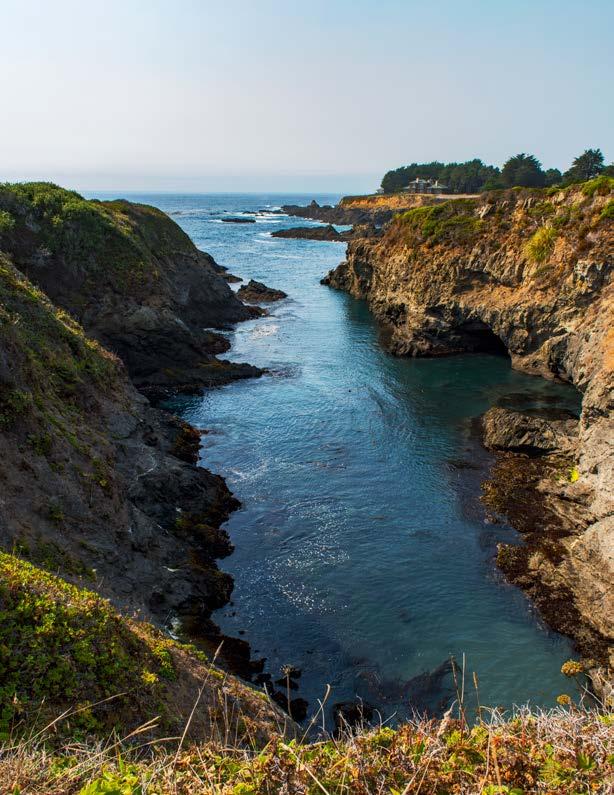
CLIMATE-RESILIENT
BUILDING A
Emily Doyle, Ph.D. (lead author)
Climate Resilience Program Manager
Rachel Norton Executive Director
Randy Widera Director of Programs
This report was informed by compiling the latest climate research, partnering with park supporters to implement on-the-ground projects, meeting with experts in natural resources and climate adaptation, and working with fellow conservation organizations. We are particularly grateful for the input of the following:
Parks California
Becky Rittenberg, Senior Resource Stewardship Programs Manager
Sempervirens Fund
Laura McLendon, Director of Land Conservation
Save the Redwoods League
Laura Lalemand, Senior Scientist
Tahoe Conservancy
Whitney Brennan, Landscape Resilience Program Supervisor
Jason Vasques, Executive Director
Climate Resolve
Lia Cohen, Coordinator, Climate Planning and Resilience
Natalie Hernandez, Director, Resilience and Organizational Strategy
Central Coast State Parks Association
Kristin Howland, Executive Director
California State Parks Foundation, an independent, member-supported nonprofit with over 50 years of history, is dedicated to protecting and preserving the California state park system for the benefit of all. We work in parks and in Sacramento with partners, park staff, and policymakers to address the challenges parks face. To make real and lasting change we are working to build a movement of people who enjoy and advocate for their parks now, and for future generations. Learn more at www.calparks.org
COVER: GAVIOTA STATE PARK
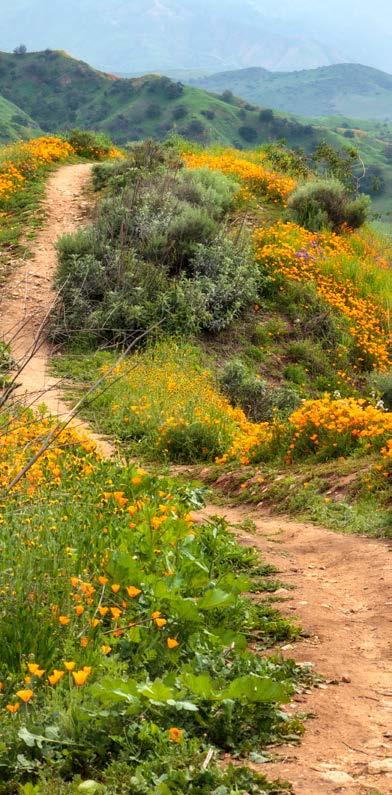 Photo courtesy of California State Parks.
Photo courtesy of California State Parks.
REPORT AUTHORS
CHINO HILLS STATE PARK
1.
2 The importance of California state parks in California’s fight against climate change
3. How do we create a climate-resilient state park system?
4. Partnerships with Native nations to address historical injustices and build climate resilience
5. Climate change and California state parks — Identifying threats and taking action
5.1
5.1.1
5.1.2
6.
7.
BUILDING A CLIMATE-RESILIENT CALIFORNIA STATE PARK SYSTEM Executive Summary
Introduction
Increasingly frequent and severe wildfires
How do we increase wildfire resilience?
Increasing wildfire resilience in California state parks: Successes, challenges, and opportunities 5.2 Sea level rise 5.2.1 How do we prepare for sea level rise? 5.2.2 Sea level rise in California state parks: Successes, challenges, and opportunities 5.3 Biodiversity and ecosystem stewardship 5.3.1 How do we conserve biodiversity throughout California?
Supporting biodiversity in California state parks: Successes, challenges, and opportunities
5.3.2
acquisition
the
Land
to support healthy landscapes, preserve biodiversity, and anticipate
effects of climate change
Preparing for extreme heat and
health
Mitigating climate change
Building a climate-resilient California state park system — How do we get there? 10. Necessary actions and recommendations References TABLE OF CONTENTS 3 5 11 15 18 22 23 27 29 30 35 36 38 43 44 47 49 50 54 55 57 66
protecting public
8.
9.
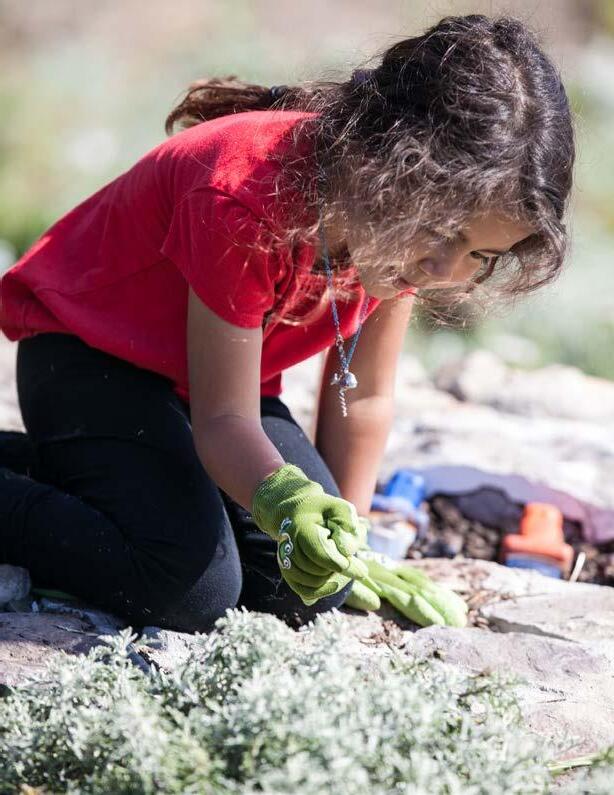 LIGHTHOUSE FIELD STATE BEACH
Photo courtesy of Tim Clinton
LIGHTHOUSE FIELD STATE BEACH
Photo courtesy of Tim Clinton
EXECUTIVE SUMMARY
California state parks are an essential part of California’s historic and cultural identity, celebrated for their dramatic landscapes, remarkable wildlife, and exciting outdoor adventures. They comprise almost one-quarter of California’s coastline, protect over 150,000 acres of coastal redwoods, and preserve a wide range of ecosystems, from coastal wetlands to inland desert to every major forest ecosystem in every region of the state. However, these cherished spaces are now increasingly threatened by climate change. Ancient sequoia groves are burning in more severe wildfires, coastal parks are being eroded by rising sea levels and intensifying storms, and endangered species that call state parks home are losing vital habitat.
This unprecedented threat requires immediate and bold action to create a climateresilient state park system that will endure for future generations. Climate resilience can no longer be one component of park management — what is required is a multidisciplinary approach to park planning and operations that builds climate resilience into all aspects of park management, from ecosystem stewardship to building climatesmart infrastructure to public outreach and education. This comprehensive view of climate resilience also considers parks’ role in California’s statewide climate efforts, such as expanding clean energy to achieve carbon neutrality by 2045. To enact this comprehensive vision of a climate-resilient state park system, sustained funding and increased hiring authority are essential to create permanent climate resilience programs informed by a diverse team of climate experts working across relevant California State Parks divisions. Adequate funding for land acquisition and community outreach and education is also critical.
The urgency of the climate crisis is clear, and climate threats will only increase in coming decades. Under a business-as-usual greenhouse gas emissions scenario (RCP 8.5), average annual maximum daily temperatures could increase by up to 5.8 °F (3.2 °C) by mid-century and by up to 8.8 °F (4.9 °C) by 2100 (relative to average 1976–2005 values).1 This future would see increasingly severe climate events with disastrous consequences. Already, warmer and drier conditions combined with over 150 years of fire suppression — resulting in the extensive buildup of dry, highly flammable fuel — have led to an unprecedented increase in the frequency, scale, and intensity of wildfires in California.2–4 In 2020, over 97% of Big Basin Redwoods State Park, the oldest state park in California, burned in California’s worst wildfire season in recorded history, and the size and severity of wildfires will only increase. Increasing parks’ resilience to wildfire is critical and requires a multidisciplinary approach that includes natural resource management, hardening structures, ensuring public access, and completing public outreach and education.
Sea level rise is accelerating due to warming oceans and melting ice sheets. The current rate of sea level rise is now more than twice the rate at the end of the 20th century, and it
5 BUILDING A CLIMATE-RESILIENT CALIFORNIA STATE PARK SYSTEM
could more than double by 20505,6 — by 2100, up to 75% of California’s beaches could disappear.7 California State Parks manages almost one-quarter of the California coast, putting state parks at the forefront of sea level rise risk and adaptation in the state. In January 2023, unprecedented winter storms inflicted an estimated $190 million of damage to coastal state parks and devastated Seacliff State Beach. These catastrophic storms foreshadow the risk to coastal parks as sea level rise — which increases storm surge and coastal damage — makes these extreme events more common.
The climate crisis is also affecting the unique ecosystems and species that make California the most biodiverse state in the country. This diversity is reflected in California’s 280 state parks, which are found in every major ecoregion of the state and protect many rare habitats and threatened and endangered species. However, this astounding biodiversity is under threat from habitat loss and climate change. Already, native species have declined 20%,8 and approximately 400 plant and animal species are listed as threatened or endangered.9,10 Restoring and stewarding parklands is key to building healthy, resilient ecosystems that can adapt to climate disturbances.
The need to prepare for and protect California state parks from climate threats is evident. State parks are also a critical resource for people facing extreme heat events and can also support state climate change mitigation efforts. Extreme heat events are becoming more frequent and are already causing increased hospitalizations and deaths,11 with the most vulnerable communities at the highest risk. As temperatures rise, parks will become increasingly important

6 CALIFORNIA STATE PARKS FOUNDATION
refuges for Californians to escape extreme heat, as described in California’s 2021 Extreme Heat Action Plan. Park access is particularly important in urban areas and for under-resourced communities that are disproportionately affected by climate change.12 California State Parks equity programs like the Golden Bear Pass ensure that lower-income residents have access to these important climate refuges, which the Outdoors for All initiative also highlights as critical for people’s physical and mental health. Climate-resilient, equitable, and accessible parks are key to supporting both California’s natural resources and its people.
It is clear that California state parks have a large role to play in California’s fight against climate change, and urgent action is needed to prepare and protect state parks for future generations. California State Parks has already taken critical steps to achieve this aim — but more must be done. This report examines the key challenges and opportunities for California State Parks to expand its climate resilience work and demonstrates that the path toward a climate-resilient state park system requires a complete rethinking of what it means to be climate resilient. California State Parks has proven itself an effective and efficient steward of California’s natural resources by leveraging its limited resources to increase climate resilience in parks and develop strategies to build a climate-resilient state park system. However, the enormity of the climate crisis demands a pace and scale of work that is not possible without policies that prioritize state parks and adequate sustained funding, including hiring authority for a multidisciplinary team of climate adaptation experts. Time is running out to protect state parks from the threat of climate change, and we must ensure that California State Parks has adequate resources to safeguard these cherished spaces for future generations.

7 BUILDING A CLIMATE-RESILIENT CALIFORNIA STATE PARK SYSTEM
SANTA MONICA STATE BEACH
RECOMMENDATIONS
Rethink California State Parks’ representation in 30x30.
COST: Neutral
Prioritizing state parks more clearly for their role in stewardship and conservation of public lands, in addition to providing recreational opportunities, in the state’s 30x30 framework would allow the agency to tap any future investments in conservation and stewardship activities across California. For example, the Nature-Based Solutions funding package for fiscal years (FY) 2021–24 allocated over $1 billion across numerous agencies, but state parks only received $12 million despite a staggering need. Future bond or budget investments should be more equitably distributed given California State Parks’ obligation to steward the many highly sensitive areas it manages. In addition, as the climate changes, more state park lands will become critically threatened and require a higher degree of conservation and stewardship.
Fund the full implementation of California State Parks’ Sea Level Rise Adaptation Strategy.
COST: $50 million in annual funding beginning FY 2025–26
California State Parks’ 2021 Sea Level Rise Adaptation Strategy lays out a multidisciplinary approach to prepare parks for sea level rise. However, the agency does not have sustained funding or permanent staff to implement the strategy. Given the exposure of coastal state parks to sea level rise, further investment for a permanent sea level rise program is essential to protect parks up and down the coast.
Authorize and fund permanent climate resilience staff across relevant California State Parks divisions (or program areas or functions) for a multidisciplinary approach to building climate resilience into all aspects of park management.
COST: $5 million+ in annual funding starting FY 2025–26
A climate resilience senior staff position should be created and permanently funded in each of the following California State Parks divisions: Natural Resources, Cultural Resources, Facilities and Park Maintenance, Strategic Planning and Recreation Services, and Interpretation and Education. The work would be completed under the guidance of an appointed Assistant Deputy Director for Climate Resilience in Park Operations.




8 CALIFORNIA STATE PARKS FOUNDATION
2 3
Expand California State Parks’ internal capacity to assess and scope adaptation projects.
COST: $10 million in annual funding beginning FY 2025–26
Due to staffing restraints, California State Parks has been forced to use external engineers and consultant firms to assess climate threats in parks and propose adaptation projects, which frequently do not fit California State Parks’ needs and values. For this work to be completed internally, the following staff positions should be created and permanently funded alongside investments for ongoing program costs: structural engineers (2), landscape architects (2), engineering geologists (2), park and recreation specialists (2), and environmental scientists (2). Staff would be assigned to a Service Center, where multidisciplinary teams provide support services for the management and enhancement of parks.
Extend funding for California State Parks’ Wildfire and Forest Resilience Program beyond its current expiration in FY 2027–28, including hiring authority for permanent staff positions.
COST: $50 million in annual funding starting FY 2028–29
California State Parks used one-time funding to create a Wildfire and Forest Resilience Program by identifying statewide objectives and supporting the development of five-year district-level wildfire resilience strategies. However, building wildfire resilience will take longer than five years, and sustained funding and a large team of permanent staff are critical for California State Parks to implement forest restoration and wildfire resilience work at the necessary pace and scale.
Establish a pilot program for California state parks as community climate resilience centers.
COST: $50 million over five years starting FY 2025–26
To develop a framework for state parks as climate refuges, the pilot program would conduct community outreach, develop implementation plans, conduct feasibility studies, and implement final community climate resilience centers at 10 state parks with diverse geographies and demographics.
Fund a robust California State Parks acquisition program.
COST: $250 million allocated from the proposed climate bond
California State Parks can acquire and restore new lands for biodiversity purposes and ensure future access to dynamic environments by anticipating how climate change will impact landscapes and acquiring and managing lands to address these threats. However, California State Parks’ acquisition program is persistently underfunded and understaffed. With a robust acquisition program, California State Parks could develop an acquisition strategy that prioritizes protecting biodiversity and maintaining access for future visitors.
9 BUILDING A CLIMATE-RESILIENT CALIFORNIA STATE PARK SYSTEM
4 5 7
 BIG BASIN REDWOODS STATE PARK
Photo courtesy of California State Parks
BIG BASIN REDWOODS STATE PARK
Photo courtesy of California State Parks
INTRODUCTION
WHAT IS A CLIMATE-RESILIENT STATE PARK?
A climate-resilient state park can prepare for, adapt to, and recover from climate impacts. This includes protecting natural and cultural resources, preserving park access, building climatesmart infrastructure, and educating Californians about parks and climate change. Climate-resilient parks also use clean energy and climate-smart land management to mitigate greenhouse gas emissions and contribute to statewide carbon neutrality.
California state parks are an essential part of California’s historic and cultural identity, celebrated for their dramatic landscapes, remarkable wildlife, and exciting outdoor adventures. They comprise almost onequarter of California’s coastline, protect over 150,000 acres of coastal redwoods, and preserve a wide range of ecosystems, from coastal wetlands to inland deserts to every major forest ecosystem in every region of the state. However, these cherished spaces are now increasingly threatened by climate change. Ancient sequoia groves are burning in more severe wildfires, coastal parks are being eroded by rising sea levels and intensifying storms, and endangered species that call state parks home are losing vital habitat. In the face of this existential threat, building a climate-resilient state park system is critical to fulfill California State Parks’ mission “to provide for the health, inspiration, and education of the people of California by helping to preserve the state’s extraordinary biological diversity, protecting its most valued natural and cultural resources, and creating opportunities for high-quality outdoor recreation.”
As the climate continues to change, our approach to park planning must change with it. California State Parks’ General Plans typically consider climate resilience as one component of park management. However, this traditional planning approach cannot prepare state parks for the unprecedented climate impacts that we are already experiencing, and a proactive and adaptable strategy is essential. What is required is a multidisciplinary approach to park planning and operations that builds climate resilience into all aspects of park management, from ecosystem stewardship to expanding green energy to public outreach and education. Climate-smart planning for California state parks will also advance the state’s climate and equity goals, such as achieving carbon neutrality by 2045, implementing the Outdoors for All initiative, and conserving nature and biodiversity, detailed in the 30x30 initiative. California state parks have a clear role to play in California’s climate future.
California State Parks has taken key steps to address immediate and long-term impacts of climate change and provide opportunities for a diverse cross-section of Californians to access the parks as never before. The agency published a Sea Level Rise Adaptation Strategy in 2021, developed five-year Wildfire and Forest Resilience strategies for park districts in 2022, and tripled the amount of forest management it is undertaking to build forest and wildfire resilience in just two years. The
11 BUILDING A CLIMATE-RESILIENT CALIFORNIA STATE PARK SYSTEM
1.
acquisition of Dos Rios Ranch State Park — the first new state park in 13 years — will also contribute to the 30x30 initiative’s aim to conserve 30% of California’s land by 2030.
However, California State Parks’ work has been hindered by a lack of sustained funding and limited authorized staff, which have prevented the establishment of permanent climate resilience programs. California State Parks’ wildfire resilience and sea level rise programs are both supported by one-time funds and depend largely on limited-term or seasonal employees, who can be difficult to recruit without guaranteed funding or long-term job stability. To meet the severity of the climate crisis, California State Parks’ climate resilience programs must be sustainably funded and staffed to bring these efforts to scale across all program areas and parks.

CALIFORNIA STATE PARKS FOUNDATION 12
CASTLE CRAGS STATE PARK
In this report, we outline how California’s state parks are being impacted by climate change and their importance to climate resilience in California. We review how California State Parks is addressing increasing wildfires, accelerating sea level rise, and biodiversity loss, as well as parks’ role as refuges for Californians facing extreme heat and other climate threats. Building climate resilience into all aspects of park management, from planning and natural resource management to deferred maintenance, is a particular focus. Lastly, we review how California State Parks can accelerate its climate resilience work and recommend several ways to achieve that goal.

13 BUILDING A CLIMATE-RESILIENT CALIFORNIA STATE PARK SYSTEM
FIGURE 1 CALIFORNIA’S DIVERSE ECOREGIONS
3)
n California Coastal Sage, Chaparral, and Oak Woodlands
n Cascades
n Central Basin and Range
n Central California Valley
n Coast Range
n Eastern Cascades Slopes and Foothills
n Klamath Mountains
n Mojave Basin and Range
n Northern Basin and Range
n Sierra Nevada
n Sonoran Desert
n Southern and Baja California Pine-Oak Mountains
Based on Bailey’s ecoregion sections (Level III), defined as areas with similar ecosystems and type, quality, and quantity of environmental resources.




Data from the United States Environmental Protection Agency. Climate types are based

CALIFORNIA STATE PARKS FOUNDATION 14
ECOREGION SECTIONS (LEVEL
JEDEDIAH SMITH REDWOODS STATE PARK (MEDITERRANEAN/SUMMER FOG CLIMATE)
DONNER MEMORIAL STATE PARK (COOL CONTINENTAL/DRY SUMMER CLIMATE)
MILLERTON LAKE STATE RECREATION (STEPPE CLIMATE)
ANZA-BORREGO (ARID LOW LATITUDE
California state park


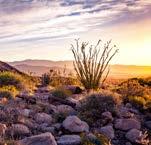
2. THE IMPORTANCE OF CALIFORNIA STATE PARKS IN CALIFORNIA’S FIGHT AGAINST CLIMATE CHANGE
As climate change forever alters the world around us, California state parks help preserve the diverse landscapes and wildlife that make California so extraordinary. California’s unique climate supports a wide range of ecosystems, such as chaparral-covered foothills in Southern California and conifer forests in the Sierra Nevada. This diversity is reflected in California’s 280 state parks, which cover 1.6 million acres from Pelican State Beach just south of Oregon all the way to Border Field State Park at the U.S.-Mexico border.
The geographical range of California state parks encompasses most of California’s significant ecoregions (Figure 1), and climate-resilient parks can protect critical habitat and local biodiversity in the face of climate change. In fact, increasing parks’ climate resilience is essential for parks to continue fulfilling their statutory purpose:
“To preserve outstanding natural, scenic, and cultural values, indigenous aquatic and terrestrial fauna and flora, and the most significant examples of ecological regions of California, such as the Sierra Nevada, northeast volcanic, great valley, coastal strip, Klamath-Siskiyou Mountains, southwest mountains and valleys, redwoods, foothills and low coastal mountains, and desert and desert mountains.”
As climate impacts worsen across California, different regions and ecosystems will face varying threats, and a range of adaptation strategies will be needed to build climate resilience. Because of their geographic and ecological diversity, state parks can be a model in climate resilience restoration and stewardship for a wide range of land managers working on increasing climate resilience at the landscape scale. Parks can also work with neighboring landowners and be at the center of a collaborative effort that extends beyond park borders.
A climate-resilient California state park system is also essential to protect California’s cultural resources and history. California’s Indigenous peoples, European settlers, and immigrants have all contributed to the state’s unique cultural heritage. Their story is recorded by preserved villages, religious sites, ancient artifacts, and other cultural treasures, many of which are in California state parks. State parks are also on Indigenous land that was stewarded by Native peoples for millennia before it was stolen,
15 BUILDING A CLIMATE-RESILIENT CALIFORNIA STATE PARK SYSTEM
RECREATION AREA
ANZA-BORREGO DESERT STATE PARK LATITUDE DESERT CLIMATE)
based on the Köppen Climate Classification System.
and this land remains a vital link to their past and present culture. By increasing state parks’ climate resilience, we can help preserve these cherished resources. However, we must also acknowledge that some climate impacts are inevitable. For example, even a small amount of sea level rise — which can no longer be prevented — could erode or completely flood ancient shell middens in coastal state parks. Therefore, it is critical not only to increase parks’ climate resilience and protect what we can but also to document what will be lost and continue to pass on California’s storied history for generations to come.


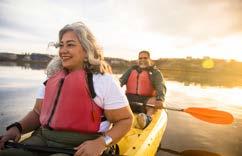
Climate-resilient state parks protect not only California’s natural and cultural resources but also its people. Severe heat waves, intensifying storms, poor air quality, and other extreme climate events are affecting Californians across the state. Because of the wide range and diversity of the state park system, California state parks can support Californians where and in the ways they need it the most. Furthermore, extreme climate events disproportionately affect marginalized and under-resourced communities.12 Urban areas dominated by pavement and human-made surfaces become heat islands compared to communities with green space.13 In sprawling Southern California, this increase can be as high as 18 °F (10 °C).14 By increasing park access and preparing parks for climate change, e.g., creating more urban parks that use renewable energy, California State Parks can build a more climate-resilient state park system and equitably increase community resilience across the state.
Climate-resilient California state parks also have an important role in climate change mitigation — reducing or offsetting greenhouse gas emissions. Transitioning park operations to renewable energy and electric vehicles will reduce parks’ carbon footprint, and climate-smart land stewardship can help promote carbon sequestration. For example, managing healthy, wildfire-resilient forests increases carbon removal and storage from the atmosphere, while decreasing the chance of large emissions from a wildfire. The importance of land management in climate change mitigation is highlighted in multiple California climate strategies, including the California Climate Adaptation Strategy and the California Air Resources Board (CARB)’s 2022 Scoping Plan, which lays out a path to carbon neutrality by 2045 (Table 1).
16 CALIFORNIA STATE PARKS FOUNDATION
TABLE 1
HOW CAN STATE PARKS CONTRIBUTE TO CALIFORNIA’S STATEWIDE CLIMATE GOALS?
CLIMATE PLAN AND OBJECTIVES
2022 CARB Scoping Plan
n Reduce greenhouse gas (GHG) emissions by 85% (relative to 1990) and achieve carbon neutrality by 2045
ROLE OF STATE PARKS
n Reduce the carbon footprint of park operations
n Contribute to California’s Natural and Working Lands Climate Smart Strategy, consistent with California State Parks’ mission, mandates, and policies, to support state GHG reduction goals
Natural and Working Lands Climate Smart Strategy
n Identify, describe, and prioritize management strategies that mitigate climate change and advance California’s broader environmental, economic, and social objectives
n Help implement Executive Order N-82-20 to expand nature-based solutions to help reach California’s climate goals, also highlighted in the California Climate Adaptation Strategy
California Wildfire and Forest Resilience Task Force — California’s Wildfire and Forest Resilience Action Plan and California’s Strategic Plan for Expanding the Use of Beneficial Fire
n Accelerate the restoration and resilience of California’s forests and natural lands, support fire-safe communities, and sustain the economic function of rural forests
n Accelerate and scale the current use of nature-based solutions like wetland restoration and implement long-term climate-smart land management strategies in park forests, shrublands, deserts, and other priority landscapes
California’s 30x30 initiative
n Durably conserve 30% of California’s land and coastal waters by 2030 to protect biodiversity, ensure access to nature, and build climate resilience
Outdoors for All
n Ensure equitable access to nature so all Californians can experience the benefits of California’s great outdoors
Extreme Heat Action Plan
n Prepare for and protect communities and natural and working lands from increasing extreme heat events caused by climate change
n Expand forest restoration and wildfire resilience efforts and incorporate beneficial fire in state parks’ land management to restore historic fire regimes and increase wildfire resilience
n Partner with Indigenous nations and groups to reintroduce Native land management practices
n Increase education around wildfire resilience to support at-risk communities and reduce human-caused ignitions
n Conserve and steward 1.6 million acres of state land
n Partner with governmental agencies, nonprofits, and Native governments to facilitate landscape-scale conservation efforts
n Support access programs, interpretive opportunities, and community engagement to create an accessible and inclusive park system that can be a climate refuge for Californians
n Support restoration efforts to increase natural land’s resilience to extreme heat, e.g., watershed restoration projects
n Serve as climate refuges for people to escape extreme heat events
17 BUILDING A CLIMATE-RESILIENT CALIFORNIA STATE PARK SYSTEM
3. HOW DO WE CREATE A CLIMATE-RESILIENT STATE PARK SYSTEM?
It is clear that California state parks have a large role to play in California’s fight against climate change, but how do we build a climate-resilient state park system? We must be able to assess climate risks, develop effective tools to meet those threats, and implement these projects at scale. But to truly build a climate-resilient state park system, we must go even further and rethink how we manage and use parks. Climate resilience can no longer be one component of park management. We must develop a multidisciplinary approach to park planning and operations that incorporates climate resilience in all aspects of park management, including stewarding nature, protecting cultural resources, building climate-smart infrastructure, transitioning to clean energy, and educating the public about climate change.
This expansive new vision of a climate-resilient state park system is already evident in initiatives like Reimagining Big Basin — which is planning how to rebuild the park after the 2020 CZU fire. Planning efforts include managing forests and natural resources, transitioning to clean energy, and developing training and educational programs about land stewardship and Indigenous land management. However, it should not take a catastrophic event to secure climate investments for state parks. Instead, guaranteed funding and authorized staff would enable California State Parks to develop permanent climate resilience programs to prepare
18 CALIFORNIA STATE PARKS FOUNDATION
CLIMATE RESILIENCE IN PARK MANAGEMENT STEWARDING NATURE PROTECTING CULTURAL RESOURCES BUILDING CLIMATE-SMART INFRASTRUCTURE TRANSITIONING TO CLEAN ENERGY EDUCATING THE PUBLIC ABOUT CLIMATE CHANGE
parks for future climate threats. Many resources are already available to support this effort. Numerous climate tools and data platforms have been developed by other state, regional, and federal agencies. For example, the National Park Service’s Climate Change Response Program is a model for a multidisciplinary approach to climate resilience that can help California State Parks build not only a more climate-resilient state park system but also a more climateresilient California.
READILY AVAILABLE CLIMATE TOOLS
California State Parks does not have to start from scratch to build a climate-resilient state park system. The agency can leverage many climate tools and data platforms that have already been developed by state, regional, and national agencies and organizations. Some examples include:
VEGETATION CLASSIFICATION AND MAPPING PROGRAM (VEGCAMP)
CAL-HEAT
An online platform to access and analyze data on extreme heat and heat health events driven by climate change
A program at the California Department of Fish and Wildlife that applies the National Vegetation Classification System to California vegetation and works with partners to develop fine-scale vegetation maps of conservation areas
CAL-ADAPT
An online platform to access and analyze climate change data from California’s Climate Change Assessments
USGS COASTAL STORM MODELING SYSTEM
A sea level rise model from the United States Geological Survey that predicts coastal flooding, erosion, and cliff failures caused by storms
CALIFORNIA WILDFIRE AND FOREST RESILIENCE TASK FORCE TREATMENT DASHBOARD AND REGIONAL RESOURCE KITS
A set of online tools and data to help accelerate wildfire resilience work at the state and regional levels
19 BUILDING A CLIMATE-RESILIENT CALIFORNIA STATE PARK SYSTEM
A MODEL FOR BUILDING A MULTIDISCIPLINARY CLIMATE RESILIENCE PROGRAM
The National Park Service Climate Change Response Program (CCRP) shows how climate resilience can be integrated throughout park management. The cross-disciplinary program integrates four components of climate change — science, adaptation, mitigation, and communication — and includes a dedicated team of staff in the following areas:
n Climate science and modeling
n Natural resource management
n Cultural anthropology
n Coastal hazards
n Park planning
n Monitoring
n Renewable energy
n Interpretation and education
The CCRP helps implement the National Park Service’s climate change priorities throughout the park system and develops important climate tools and resources, such as guidelines for vulnerability assessments and comprehensive climate adaptation strategies. Successful projects addressing each component of climate change include:
SCIENCE
Developing a database of climate change projections and effects at individual parks
ADAPTATION
Working with parks to assess how future climate conditions and adaptation needs will influence park management
MITIGATION
Providing data about carbon storage in parks that can inform climatesmart land management that could offset carbon emissions
COMMUNICATION
Developing a National Climate Change Interpretation and Education Strategy
The success of the National Park Service’s CCRP shows what can be accomplished with a dedicated team of climate change experts working across departments. The CCRP can serve as a model for California State Parks to develop and implement its own comprehensive vision for building a climate-resilient state park system.
20 CALIFORNIA STATE PARKS FOUNDATION
 REDWOOD NATIONAL AND STATE PARKS
Photo courtesy of California State Parks
REDWOOD NATIONAL AND STATE PARKS
Photo courtesy of California State Parks
4. PARTNERSHIPS WITH NATIVE NATIONS TO ADDRESS HISTORICAL INJUSTICES AND BUILD CLIMATE RESILIENCE
Indigenous peoples have lived on, cared for, and stewarded California’s stunning landscapes for thousands of years. For many Native nations, their connection to the land is central to their identity, and ancestral homelands are considered sacred and have spiritual significance. When settlers arrived in California, they forcibly removed Indigenous peoples from their rightful homelands, and this connection was lost for many Native communities. This history of racism, dispossession, and marginalization has left a legacy for Californians that must be confronted. California residents must reexamine their past, acknowledge past wrongs, and reconcile these injustices toward Indigenous peoples.
California State Parks recognizes this need and is building relationships with Native nations to restore their access and rights to their traditional homelands. This includes establishing Memorandums of Understanding (MOUs) between California State Parks and Native nations for co-management of Native land in state parks. For example, an MOU was signed with the Yurok Tribe in 2022 for the cooperative management of the Tribe’s ancestral lands in California State Parks’ Redwoods North Coast District. California State Parks is also working with Native nations to create educational opportunities for Native youth and all Californians to learn about the history of Native nations who share geography with California.
Incorporating traditional ecological knowledge in park management is also key to building a climate-resilient state park system. Native nations have been successful stewards of California’s natural resources for millennia,15,16 and California State Parks can work with and learn from Indigenous peoples to make parks more wildfire resilient and restore and preserve the diverse habitats that support California’s extraordinary biodiversity. Successful, reciprocal partnerships with Native peoples are highlighted throughout the report — emphasizing their central role in addressing historic injustices and building a climate-resilient California state park system.
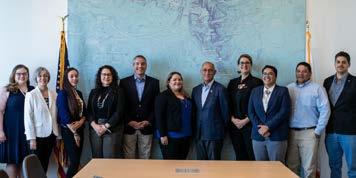
22 CALIFORNIA STATE PARKS FOUNDATION
all rights reserved
REPRESENTATIVES OF THE YUROK TRIBE, NATURAL RESOURCES AGENCY SECRETARY WADE CROWFOOT, AND CALIFORNIA STATE PARKS STAFF AT THE MOU SIGNING.
©California State Parks,
5. CLIMATE CHANGE AND CALIFORNIA STATE PARKS — IDENTIFYING THREATS AND TAKING ACTION
California state parks are already seeing adverse impacts from climate change, which will only worsen as temperatures continue to rise (Figure 2). By the end of the century, the annual average maximum daily temperature could increase by 5.6–8.8 °F (3.1–4.9 °C) (relative to average 1976–2005 temperatures and under moderate-to-high greenhouse gas emissions scenarios), and the average annual temperature could reach almost 80 °F (27 °C) (Table 2).1 This future would see increasingly severe climate events with disastrous consequences, including more frequent and severe wildfires; accelerating sea level rise, coastal erosion, and flooding; and ecosystem deterioration and habitat loss that threaten California’s extraordinary biodiversity.

Larger, more frequent, and
Accelerating sea level rise that increases coastal erosion and flooding, threatens coastal infrastructure, and may reduce public access
More frequent and longer extreme heat events that increase wildfire risk and threaten public health
Prolonged drought and decreased winter-spring Sierra snowpack
23 BUILDING A CLIMATE-RESILIENT CALIFORNIA STATE PARK SYSTEM
more severe wildfires
Increased spread of pests and disease that increase tree mortality
Ecosystem deterioration and habitat loss due to legacy infrastructure and exacerbated by climate change
PROJECTED TEMPERATURE INCREASES IN CALIFORNIA (°F)
Projected increase in the annual average maximum daily temperature under moderate (RCP 4.5) and high (RCP 8.5) greenhouse gas emissions scenarios relative to 1976–2005 temperatures. Average annual temperatures shown in parentheses. Data is from climate projections completed for California’s Fourth Climate Change Assessment.1
California State Parks must also prepare for oscillating climate extremes. For example, reduced winter-spring snowpack is contributing to prolonged droughts, and a 2021 study suggests that the Sierra Nevada snowpack could largely disappear by 2050.17 However, the record snowpack in 2023 — more than 230% of the average18 — highlights the climate whiplash that may become California’s norm and make climate adaptation an even greater challenge. For California state parks, early melt and increased flooding downstream could limit recreational opportunities and increase operational costs at reservoir parks.
Meeting these threats will require not only significant resources but also partnerships with government agencies, Native nations, and other supporting organizations. Education and public outreach are also critical to teach Californians how they can help fight climate change. Over 80 million people visit California state parks every year, making educational and interpretive programs at parks an excellent opportunity for people to learn about issues like climate-smart land management, how to reduce their carbon footprint, and how to help prevent human-caused wildfires. Furthermore, greater education about Indigenous stewardship will show park visitors that they can live sustainably with the land while still enjoying nature.
24 CALIFORNIA STATE PARKS FOUNDATION
TABLE 2
EARLY CENTURY (2006–2039) RCP 4.5 RCP 8.5 MID-CENTURY (2040–2069) LATE CENTURY (2070–2100) +2.5 (72.6) +4.4 (74.5) +5.6 (75.5) +2.7 (72.8) +5.8 (75.9) +8.8 (78.9)
IN CALIFORNIA: PROJECTIONS OF THE STATEWIDE ANNUAL AVERAGE MAXIMUM TEMPERATURE
88 °F
84 °F
80 °F
High Emissions Projection (RCP 8.5)
Moderate Emissions Projection (RCP 4.5)
Modeled Historical Observed
72 °F
68 °F
Source: Cal-Adapt. Data from LOCA Downscaled CMIP5 Climate Projections (Scripps Institution of Oceanography), Gridded Observed Meteorological Data (University of Colorado Boulder), LOCA Derived Products (Geospatial Innovation Facility). Plot adapted from Reimagining Big Basin
The following sections detail major climate threats to California state parks, including wildfire, sea level rise, and loss of biodiversity. They discuss California State Parks’ past and current climate resilience work, challenges faced, and what resources are needed to expand these efforts and build a climate-resilient state park system.
25 BUILDING A CLIMATE-RESILIENT CALIFORNIA STATE PARK SYSTEM
76 °F
1980 1960 2000 2040 2020 2080 2060 2100
FIGURE 2 CLIMATE CHANGE
 SONOMA COUNTY
SONOMA COUNTY
5.1 INCREASINGLY FREQUENT AND SEVERE WILDFIRES
Years of fire suppression combined with accelerating climate change have led to an unprecedented increase in the frequency, scale, and intensity of wildfires in California.2–4 Longer droughts and drier conditions are making fires burn larger and hotter,19 and drought-stressed trees are more susceptible to pests and pathogens, such as bark beetles in conifer forests, pine canker in coastal bishop pine forests, and more.20,21 These effects cause greater tree mortality, and therefore create more fuel to drive wildfires.22,23 These climate effects exacerbate the fuel buildup from 150 years of fire suppression that began with the theft of Indigenous lands and the banning of Native burning practices. The result is that California forests have turned into tinderboxes, and fire season is now year-round. In 2020, California saw the worst fire season in its recorded history. Over 4 million acres of land burned — around 4% of the entire state — and large, severe wildfires caused catastrophic damage across California, including burning 97% of Big Basin Redwoods State Park, the oldest state park in California.
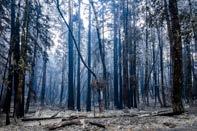
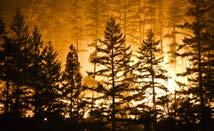
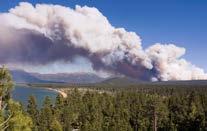
Climate projections suggest an even starker future for wildfires in California. Scientists have estimated that under a high greenhouse gas emissions scenario (often called the businessas-usual scenario), wildfires could burn 77% more acres a year by 2100, with one model even suggesting a possible increase of 178% in acres burned (relative to 1961–1990).1 More fire is actually necessary to create and maintain fire-resilient landscapes, and some state parks have experienced ecological benefits from low-severity wildfires.24 However, the increasing size and severity of these fires will have severe consequences for affected ecosystems — such as the conversion of forests to shrublands — as well as surrounding communities.25
The ancient redwoods of Big Basin Redwoods State Park are still standing, though blackened by searing heat and flames. However, not all parks will be as fortunate, and preparing the land for eventual wildfire is essential to reduce the severity of future wildfires and prevent the catastrophic damage seen at Big Basin Redwoods State Park. Land stewardship to increase wildfire resilience also supports ecosystem recovery after a wildfire because less-severe fires stimulate growth, create more diverse habitat, and have other beneficial impacts, ensuring that parks can recover from future wildfires.
27 BUILDING A CLIMATE-RESILIENT CALIFORNIA STATE PARK SYSTEM
CALIFORNIA’S JOSHUA TREES UNDER THREAT

The unprecedented increase in wildfire frequency and severity is threatening California’s Joshua trees. Prolonged drought and increased temperatures from climate change are already increasing Joshua tree mortality and shrinking suitable habitat, and wildfires now pose a greater risk than ever. In 2020, the Lake Fire burned over 55 acres of Arthur B. Ripley Desert Woodland State Park. Combined with the Dome Fire in the Mojave Desert, over 1 million Joshua trees were killed by wildfire that year. Environment scientists at California State Parks are working to preserve this rare species, including studying post-fire tree regeneration and evaluating restoration techniques. However, Joshua trees only grow at rates of one-half to three inches per year, and the loss of these unique trees may be irreversible, further highlighting the need for climate-resilient California state parks.
ARTHUR B. RIPLEY DESERT WOODLAND STATE PARK
Photo courtesy of California State Parks
5.1.1 HOW DO WE INCREASE WILDFIRE RESILIENCE?
Returning beneficial fire to the landscape is essential to increase wildfire resilience across the state, including California state parks. For thousands of years, Native peoples used fire to maintain meadowlands, fell trees, and increase plant productivity for harvest.16 They also set fires to remove thick brush and other biomass that could fuel a catastrophic wildfire.15 Naturally occurring wildfires, such as those started by lightning strikes, further clear out potential wildfire fuel. The frequency and severity of wildfires, called the fire regime, depended on the landscape.26,27 For example, redwood forests experienced frequent, low-intensity fires, and trees developed thick bark that protects them from fire.28 Chaparral regions in Southern California experienced infrequent, high-intensity fires that allowed native vegetation to regrow between each disturbance.29 However, fire-resilient redwoods are now being killed in severe wildfires, and chaparral vegetation cannot recover between too-frequent fires, resulting in the invasion of faster-growing grasses and eventual ecosystem conversion.25,30 Restoring these landscapes’ historic fire regime through beneficial fire or ignition prevention is critical to protect these ecosystems and increase wildfire resilience.
Prescribed burns are a critical tool to reintroduce beneficial fire to the landscape while minimizing risk to natural and cultural resources and surrounding communities. Treatment sites may need to be prepared beforehand with selective tree thinning, clearing thick layers of leaves and pine needles from the forest floor, or using other fuel treatment methods to maximize efficacy and control fire severity and behavior.31 Experts on the ground are also critical to ensure the burn is safe, contained, and effective, and working with Indigenous peoples to incorporate traditional knowledge is essential to successfully return fire to the ground. Fire can also be reintroduced to the landscape by allowing wildfires to burn. This technique, called managed wildfire, leverages the benefits of wildfire to promote overall ecosystem health and increase wildfire resilience.32 Managed wildfires also require extensive resources and staff, and cooperation between land managers like California State Parks and fire suppression agencies is essential to facilitate managed wildfires when appropriate.
Returning fire to the landscape is key to restoring natural fire regimes; however, additional actions are essential to build climate resilience. Structural hardening and creating defensible space around infrastructure can help protect valuable assets like park visitor facilities from potential wildfires. Similarly, when building and repairing damaged infrastructure, wildfire risk must be considered in all planning efforts to ensure that structures are built where and in ways that make sure they will be the most wildfire resilient. This approach requires a shift in people’s perspectives of deferred maintenance in state parks, which can no longer mean rebuilding as was but must be proactive to anticipate and attenuate future climate threats.
Education is also essential so that Californians understand the connection between wildfire, land management, and human behavior. Returning fire to the ground is critical to attenuate wildfire risk, but many people and communities are often hesitant or in opposition to
29 BUILDING A CLIMATE-RESILIENT CALIFORNIA STATE PARK SYSTEM
prescribed burning. Improved messaging and outreach can help address these concerns, such as explaining that lower smoke exposure from scheduled prescribed fires is preferable to large smoke emissions from unplanned wildfires. Education efforts are also important in regions like chaparral-dominated Southern California. Unlike many forest landscapes, chaparral ecosystems have experienced too much fire instead of too little, and wildfires are becoming more frequent not because of fuel buildup, but because of increased human-caused ignitions.33 Therefore, public education is key to reducing wildfire risk in these areas, particularly as communities continue to expand and the wildland-urban interface continues to grow.
5.1.2. INCREASING WILDFIRE RESILIENCE IN CALIFORNIA STATE PARKS: SUCCESSES, CHALLENGES, AND OPPORTUNITIES
California State Parks has effectively used its limited resources to increase wildfire resilience in state parks. Since 2021, California State Parks has been allocated a total of $160 million for wildfire and forest resilience work — $120 million in late fiscal year (FY) 2020–21 and FY 2021–22 and an additional $20 million in both FY 2022–23 and FY 2023–24. The agency used some of this funding to complete over 5,000 acres of forest restoration and wildfire resilience work in 2022,34 and it will continue these efforts until funding expires in FY 2027–28. However, after this one-time funding expires, California State Parks will be unable to scale this work to meet the urgency of the climate crisis as highlighted in California’s Wildfire and Forest Resilience Action Plan. Furthermore, funding included only five permanent staff positions, which falls far short of what California State Parks will need to expand its wildfire resilience efforts.
California State Parks has shown its effective use of funds by completing significant wildfire resilience work at numerous state parks — forest restoration at Castle Crags State Park and managed wildfire at Henry W. Coe State Park are just two examples of the agency’s success. However, the lack of sustained funding threatens the long-term efficacy of this work. Without continued management, the scenic hills of Henry W. Coe State Park and the cool forests of Castle Crags State Park will again become overgrown with fuel. This result would be a large step backward at significant fiscal cost because maintaining the completed work — such as conducting regular prescribed burns — is significantly cheaper than repeating extensive thinning after letting the area revert to its original state.35 Therefore, consistent adequate funding is essential to ensure that resources do not go to waste.
To implement a cohesive vision of wildfire resilience, California State Parks has created a Wildfire and Forest Resilience Program by identifying statewide objectives and supporting the development of five-year district-level strategies that articulate an overall vision for future desired conditions for forests and other wildlands, and for the workforce, training, permitting, and multidisciplinary needs to achieve them. Elements of these district strategies also describe key facility, public access, interpretation and education, and public messaging needs as applicable and relevant. However, one-time funding and limited hiring authority threaten
30 CALIFORNIA STATE PARKS FOUNDATION

BENEFICIAL FIRE IN CALIFORNIA STATE PARKS
Successful wildfire resilience projects have been completed at dozens of parks across the state. Since 2020, over 400 acres of prescribed burns have been completed in Castle Crags State Park, a hidden gem known for its granite spires, which are over 170 million years old and 6,000 feet tall. This work has increased the resilience of over 28 miles of hiking trails, including a portion of the iconic Pacific Crest Trail.
California State Parks also used managed wildfire with great effect at Henry W. Coe State Park during the SCU wildfire in 2020. With many resources committed to the concurrent wildfire at Big Basin Redwoods State Park, California State Parks monitored and controlled the fire at Henry W. Coe State Park but allowed it to burn. The managed fire was a success, clearing out fallen trees and other excess fuel without damaging tree canopies or seed banks in the soil. Furthermore, the fire left patches of unburnt vegetation that can shelter wildlife and will benefit plant ecology over time.
 HENRY W. COE STATE PARK AFTER THE 2020 SCU LIGHTNING COMPLEX FIRE, WHICH CLEARED THE OVERGROWN UNDERSTORY (TOP) AND LEFT A MOSAIC OF VEGETATION (BOTTOM) WITH SHORT- AND LONG-TERM ECOLOGICAL BENEFITS.
Photo courtesy of Wes Gray, California State Parks
HENRY W. COE STATE PARK AFTER THE 2020 SCU LIGHTNING COMPLEX FIRE, WHICH CLEARED THE OVERGROWN UNDERSTORY (TOP) AND LEFT A MOSAIC OF VEGETATION (BOTTOM) WITH SHORT- AND LONG-TERM ECOLOGICAL BENEFITS.
Photo courtesy of Wes Gray, California State Parks
3,500
IN 2022, CALIFORNIA STATE PARKS COMPLETED: acres prescribed burns
2,500 acres fuels reduction state parks
42

Acreage treated according to California Wildfire and Forest Resilience Task Force Interagency Treatment Dashboard
California State Parks plans to conduct prescribed burns in at least 100 state parks before current funding expires in FY 2027–28. This expansion aligns with the California Wildfire and Forest Resilience Task Force’s strategy to increase the use of beneficial fire and conduct wildfire resilience treatments for at least 500,000 acres of state-owned land every year by 2025.
32 CALIFORNIA STATE PARKS FOUNDATION
CREWS CONDUCT A PRESCRIBED BURN NEAR HUMBOLDT REDWOODS STATE PARK.
Photo courtesy of Laura Lalemand, Save the Redwoods League
the long-term implementation of these strategies as part of a permanent wildfire resilience program. Current funding expires in five years, but building wildfire-resilient state parks is not a five-year effort — it will take decades of work to restore natural fire regimes in park ecosystems and ensure they are not lost to increasingly frequent and severe wildfires. Therefore, guaranteed funding and permanent staff for California State Parks’ Wildfire and Forest Resilience Program are essential.
CRITICAL ACTIONS
To extend funding for California State Parks’ Wildfire and Forest Resilience Program beyond its current expiration in FY 2027–28, allocate $50 million in annual funds beginning FY 2028–29, including hiring authority for dedicated staff positions.
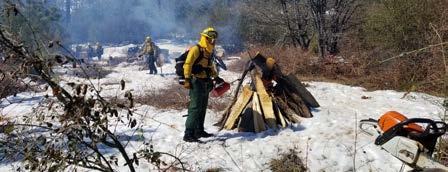
California State Parks has partnered with Native governments, the San Diego River Conservancy, the Resource Conservation District, and others to pilot the Native American Conservation Corps (NACC) in the Colorado Desert District in Southern California — the largest district in the park system and home to 18 of the 109 federally recognized Tribes in California, with another ~40 currently applying for recognition. This program’s goal is to offer opportunities for Native peoples to return to their rightful homelands, train local Native youth in fire management, and return historic fire management to the landscape. The NACC also builds a potential workforce for California State Parks’ Wildfire and Forest Resilience Program. The 2022 pilot program was a success. Seven participants received their firefighter certificates along with valuable on-the-ground job experience, and three of the team members were hired by California State Parks to continue working in fire management to increase wildfire resilience. California State Parks has the opportunity to build on the NACC program and create a Memorandum of Understanding with Native nations for the co-management of state park land.
33 BUILDING A CLIMATE-RESILIENT CALIFORNIA STATE PARK SYSTEM
THE NATIVE AMERICAN CONSERVATION CORPS: BUILDING WILDFIRE RESILIENCE IN CALIFORNIA STATE PARKS’ COLORADO DESERT DISTRICT
NACC PARTICIPANTS CONDUCT A PRESCRIBED BURN IN CUYAMACA RANCHO STATE PARK.
Photo courtesy of Danny McCamish, California State Parks
 CRYSTAL COVE STATE PARK
CRYSTAL COVE STATE PARK
5.2 SEA LEVEL RISE
Sea level rise is accelerating because of warming oceans and melting ice sheets. According to the 2021 Intergovernmental Panel on Climate Change 6th Assessment Report, sea level is rising at 0.1–0.2 inches (3.2–4.2 millimeters) per year,36 more than twice the rate at the end of the 20th century6 and faster than during any century in the past ~3,000 years.37 To evaluate how sea level rise will affect California, the California Ocean Protection Council created a Science Advisory Committee Team in 2017 to develop Rising Seas in California: An Update on Sea-Level Rise Science. This comprehensive report was followed by the 2018 update — State of California Sea-Level Rise Guidance. The report found that California could experience up to almost 7 feet (~2 meters) of sea level rise by the end of the century, depending on future greenhouse gas emissions (Figure 3). However, uncertainty about the future behavior of the Antarctic Ice Sheet means that this number could be significantly higher. An updated version of this report will be released in 2024.
FIGURE 3 SEA LEVEL RISE ALONG THE CALIFORNIA COAST
Projected sea level rise (relative to the mean sea level measured from 1991 to 2009) at three tide gauge locations in California based on moderate (RCP 4.5) and high (RCP 8.5) greenhouse gas emissions scenarios. Values are reported for three time periods through 2100, with all data sourced from Rising Seas in California: An Update on Sea-Level Rise Science and the references cited therein. Shaded projections show the maximum “likely” amount of sea level rise, defined as having a ~66% probability of occurrence. Dashed projections show an extreme sea level rise scenario with a 0.5% probability of occurrence.
Sea level rise is already having drastic impacts on California’s shoreline, such as increased flooding,38 accelerating coastal erosion,39 shrinking coastal wetlands,40 and disappearing beaches.7 Sea level rise exacerbates storm surges41,42 — the abnormal rise of sea level caused during a storm — and wave run-up, meaning powerful waves reach further inland to threaten
BUILDING A CLIMATE-RESILIENT CALIFORNIA STATE PARK SYSTEM 35
1 2 3 4 5 6 7 8 San
Relative Sea Level Rise (feet) RCP 4.5 RCP 8.5 2030 2050 2100 Extreme scenario (0.5% probability)
Francisco Golden Gate La Jolla Crescent City
coastal communities and landscapes.43 Rapidly crumbling ocean cliffs are an imminent threat to coastal infrastructure, and undermined staircases and walkways impede public access and threaten public safety. The costs of sea level rise are already being felt by the 128 California state parks within the coastal zone.
As sea levels continue to rise, the future of California’s famous coastline and coastal parks is uncertain. Preliminary modeling in 2017 estimated that 5 feet (~1.5 meters) of sea level rise and a 100-year storm event would flood 593 structures, 150 acres of parking lots, 93 campgrounds and day-use areas, and 65 miles of roads in state parks.44 Current satellite measurements suggest that the rate of sea level rise could reach 0.3 inches (6.6 millimeters) per year by 2050.5,6 Following this trajectory, up to 75% of California’s beaches could disappear by the end of the century,7 and the impact to state parks will be severe. This devastating future is approaching faster than ever, and building a resilient coastline is essential.
5.2.1. HOW DO WE PREPARE FOR SEA LEVEL RISE?
Strategies to prepare for sea level rise range from coastal armoring to nature-based solutions to managed retreat.42 Hard armor, including seawalls and rock revetments, started being built early in the 20th century and proliferated in the 1980s, when a climate shift over the Pacific Ocean led to stronger and more frequent El Niño events. However, these structures damage the surrounding ecosystem and can lead to complete beach erosion and habitat loss by preventing natural inland migration as sea levels rise.45 Seawalls and other built structures can
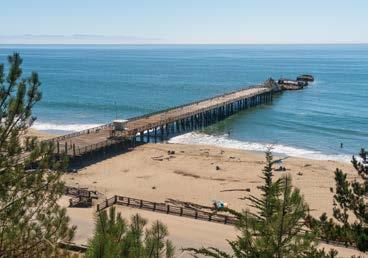

CALIFORNIA STATE PARKS FOUNDATION 36
IN JANUARY 2023, UNPRECEDENTED WINTER STORMS INFLICTED DEVASTATING DAMAGE TO SEACLIFF STATE BEACH, ULTIMATELY RESULTING IN THE DEMOLITION OF ITS HISTORIC PIER.

also impede public access to the coast and are only a temporary solution, as most hard structures eventually fail due to undermining and shoreline erosion, overtopping, or battering from increasingly powerful waves.46 Since it was built in 1926, the seawall at Seacliff State Beach has been severely damaged or destroyed by extreme storms more than 10 times. Hard armor is still used to protect critical assets, ranging from airports to campgrounds. However, the balance between protecting infrastructure and conserving the shoreline must be carefully considered.
Increasing attention is now focused on nature-based solutions, which leverage the innate protective qualities of coastal ecosystems to build resilience and attenuate the impacts of sea level rise for the surrounding area.47–49 In 2020, Governor Newsom signed Executive Order N-82-20, calling for the expansion of nature-based solutions to the climate crisis. For coastal sites, this includes coastal wetland restoration, vegetated sand dunes, and more. These nature-based solutions can reduce inland flooding, protect vulnerable facilities, and even increase public access — again showing that climate resilience is built into all aspects of park use and management.
Proactive, adaptive management is also key to building resilient coastal state parks, which must adapt in a dynamic coastal environment. For example, nature-based solutions may attenuate local sea level rise in the short term, but we must recognize the inevitable impacts of sea level rise in the future and plan accordingly. This includes creating space for coastal ecosystems to adapt over time, preserving and documenting cultural resources, and
SEACLIFF STATE BEACH: A PREVIEW OF COASTAL PARKS’ FUTURE?
The exposure of state parks to coastal threats was on full display in January 2023, when unprecedented winter storms inflicted an estimated $190 million of damage to coastal state parks. Seacliff State Beach, one of California’s first state beaches, was hit particularly hard. Pounding waves, powerful storm surge, and heavy winds destroyed infrastructure, flooded the campground, and caused irreparable damage to the beach’s historic pier, ultimately resulting in its demolition. The protective seawall and paved walkways were also lost, having already been undermined by coastal erosion. The catastrophic damage irrevocably changed the way Californians will access and use the park in the future. Though the campground could reopen, it is only a matter of time before the next storm hits. Therefore, rebuilding and repairs must consider these future threats instead of rebuilding as was. These catastrophic storms foreshadow the future of coastal state parks with additional sea level rise — which will increase storm surge and damage to coastal parks — highlighting the urgency of preparing state parks for more severe storm events in the future.
BUILDING A CLIMATE-RESILIENT CALIFORNIA STATE PARK SYSTEM 37
rethinking our approach to deferred maintenance. Facilities can no longer be rebuilt as was — deferred maintenance and planning must consider the strategic modification or relocation of facilities to increase their climate resilience. For example, staircases that provide coastal access can be undercut by increasing erosion and need repair. However, to rebuild smartly and ensure continued public access, the placement and design of these access points may need to be reconsidered.
Relocating facilities is one component of managed retreat, which is the purposeful movement of people, infrastructure, and other assets away from areas vulnerable to climate change. Managed retreat can be controversial but is likely inevitable,50 and extensive public outreach and education are essential to explain the benefits — in terms of sustainability and cost savings — of preparing now instead of waiting for a disaster. This is an opportunity for California State Parks to lead the way to a more sustainable future. At Seacliff State Beach, for example, beachside campsites may no longer be sustainable, and the campground may need to be relocated to a more appropriate location.
5.2.2 SEA LEVEL RISE IN CALIFORNIA STATE PARKS: SUCCESSES, CHALLENGES, AND OPPORTUNITIES
California State Parks has made great strides in preparing the state park system for the effects of sea level rise, including individual adaptation projects and the development of the Sea Level Rise Adaptation Strategy, which lays out a comprehensive approach to prepare state parks for sea level rise, including integrating adaptation into coastal projects and planning, working with partners, and increasing public awareness. In the 2021–22 Budget Act, California State Parks received a historic allocation of $11.5 million to support its sea level rise work. However, these funds were a one-time investment and did not include any dedicated staff or ongoing program costs, preventing the establishment of a coherent sea level rise program. California State Parks’ first round of identified sea level rise adaptation projects is currently scoped at over $2.5 million, and larger projects like relocating campgrounds — which will only become more necessary as sea levels continue to rise — can cost tens of millions of dollars. Given the exposure of coastal state parks to sea level rise, additional funds are essential to ensure these parks are protected and can continue to provide access in a dynamic coastal environment.
California State Parks’ Sea Level Rise Adaptation Strategy provides a coherent plan for coastal parks to address sea level rise. Without permanent staff, Sea Grant Fellows were instrumental in coordinating a multidisciplinary working group to develop and finalize the strategy, which now provides the road map and tools parks need to implement sea level rise projects up and down the coast. The development of this important document shows what can be accomplished with dedicated staff in the sea level rise program, but permanent staff is essential for the long-term implementation of this adaptation strategy.
California State Parks has already piloted a key element of its Sea Level Rise Adaptation Strategy in the San Diego Coast District — developing vulnerability assessments to guide
38 CALIFORNIA STATE PARKS FOUNDATION
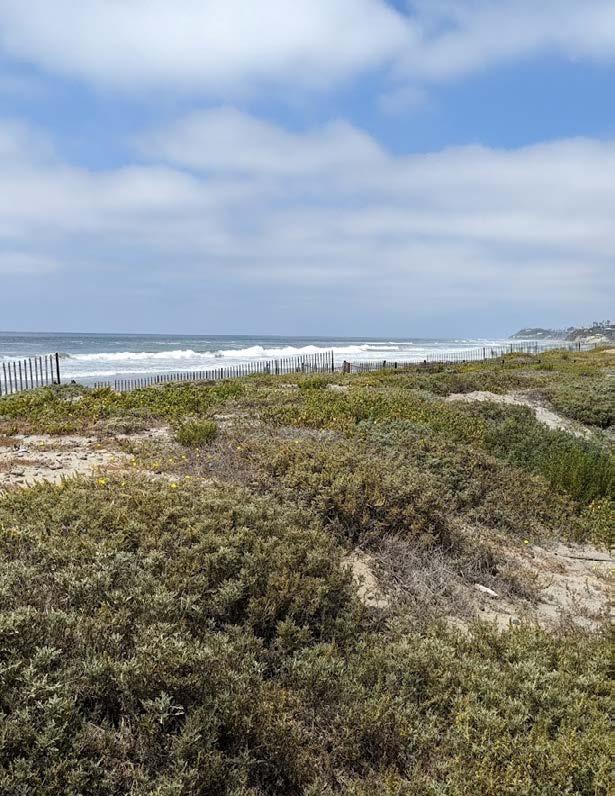
SEA LEVEL RISE ADAPTATION PROJECTS IN CALIFORNIA STATE PARKS
California State Parks has already achieved significant success preparing parks for sea level rise. For example, a living shoreline was built at Cardiff State Beach in 2019, including sand dunes, native plants, and a pedestrian path for walking and biking access. This project successfully prevented or reduced flooding of the adjacent South Coast Highway 101 during the severe winter storms in January 2023, while simultaneously increasing public access.
At San Onofre State Beach, California State Parks has built managed retreat into long-term planning to address ongoing shoreline erosion, including preserving park access in the future.
California State Parks has also worked with nonprofits to complete large-scale adaptation projects. In 2012, the agency partnered with California State Parks Foundation to restore 7.5 acres of wetlands at Yosemite Slough in Candlestick Point State Recreation Area. This restoration project will not only alleviate the effects of sea level rise but also restore access to the coast for the underserved Bayview-Hunters Point community.
CARDIFF STATE BEACH’S LIVING SHORELINE
Photo courtesy of Brian Leslie, GHD
future adaptation and planning work. However, without sufficient internal planning, engineering, and other technical staff, California State Parks has had to engage outside engineers and consultant firms to conduct vulnerability assessments and determine potential adaptation options. California State Parks has a very different mission than these firms’ usual clients, such as municipalities and homeowner associations, so parks require a very different management approach. As such, the assessments these contractors provide must be adapted to fit California State Parks’ needs. For example, the initial assessment for San Elijo State Beach was submitted in mid-2023 and, though useful from a broader perspective, it cannot be applied to parks without being modified.
Permanent and dedicated staff is also critical because of the complexity in project implementation. When and how to complete sea level rise adaptation projects involves difficult trade-offs that require a wide range of input and consideration, and experienced staff is essential to effectively make these decisions. This need is exemplified by the planning efforts at Seacliff State Beach, where a vulnerability assessment is currently underway. If the assessment determines that the campground should not be rebuilt, where will people camp? What about the vulnerable access road that residents need in order to reach their homes? How do we ensure visitor facilities can survive future storms, and how do we preserve public access while doing so? And what are the long-term consequences of these decisions, both fiscally and for the environment? Many parks will have to answer these questions in the coming years, and though the details will vary, the diverse knowledge and experience required to make these decisions will be universal. As such, dedicated staff in significant program and management areas — such as natural resources, facilities, and operations — is essential to align adaptation efforts and prepare coastal state parks for the inevitable impacts of sea level rise.
The future of coastal state parks must also include land acquisition. Short- and mid-term adaptation measures, such as coastal ecosystem restoration and relocating facilities, will inevitably be overtaken by sea level rise, increased coastal erosion, and other processes that will cut off public access to these parks. California State Parks has the opportunity to provide access for future Californians with a strategic acquisition program that prioritizes sites for future coastal access and restoration opportunities.
CRITICAL ACTIONS
Allocate $50 million annually beginning in FY 2025–26 to enable full implementation of California State Parks’ Sea Level Rise Adaptation Strategy, including completing major sea level rise adaptation and resilience projects in state parks, developing guidelines for vulnerability assessments and adaptation plans, and hiring dedicated staff to create a permanent sea level rise program.
40 CALIFORNIA STATE PARKS FOUNDATION
 SAN ELIJO STATE BEACH
SAN ELIJO STATE BEACH
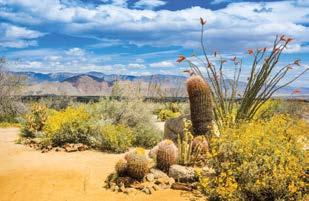











5.3 BIODIVERSITY AND ECOSYSTEM STEWARDSHIP
California has extraordinary biodiversity because of its geographic and climatic diversity. Over 6,500 native plant species, 1,000 native vertebrate species, and 30,000 insect species call California home, and a significant number of these species are endemic, meaning they are found nowhere else in the world.51 However, this rich biodiversity is decreasing at an alarming rate due to habitat loss and climate change. Human activity has degraded ecosystems and destroyed key habitats, and legacy infrastructure such as river dams and filled estuaries has significantly impacted numerous California species. Already, native species have declined by 20%,8 and approximately 400 plant and animal species are listed as threatened or endangered.9,10 In the face of this biodiversity crisis, California state parks are key to preserving vital habitat for species across the state, from coniferous forests to expansive grasslands.
Chino Hills State Park is a prime example of California state parks’ role in protecting California’s extraordinary biodiversity. Chino Hills State Park has one of the greatest diversities of native plants and animals in the United States,52 including numerous threatened and endangered species like the coastal cactus wren. The park is also a critical biological corridor for wildlife, meaning it connects smaller, isolated areas of habitat that would otherwise restrict species’ movement and decrease their chance of survival. However, Chino Hills State Park is increasingly threatened by wildfires driven by climate change and increased human ignitions. In fact, the number of fires at Chino Hills State Park was almost 50% higher between 2012 and 2018 than over the entire previous century — fires occurred every 11 months compared to the historic 30-to-150-year fire return interval53 — and over 60% of the park burned in the 2020 Blue Ridge Fire.52 This high fire return interval is a direct threat to Chino Hills State Parks’ biodiversity, including the park’s rare walnut woodlands. Only several thousand acres of these woodlands remain in California, and this vital habitat could be lost.
Growing climate threats and habitat destruction suggest a dangerous future not only for Chino Hills State Park but also for California’s biodiversity statewide. For example, the majority of endemic plant species could lose up to 80% of their habitat,54 and nearly half of California’s salmon, steelhead, and trout are likely to become extinct in the next 50 years if current trends continue.55 Many native California species are at risk, including the iconic western monarch butterfly, majestic giant sequoia redwoods, and spectacular Joshua trees stretching across the Mojave Desert. These beloved species all call California state parks home, and proper land conservation and ecosystem stewardship are essential to ensure California’s extraordinary biodiversity does not disappear.
43 BUILDING A CLIMATE-RESILIENT CALIFORNIA STATE PARK SYSTEM
5.3.1 HOW DO WE CONSERVE BIODIVERSITY THROUGHOUT CALIFORNIA?
Climate-smart landscape stewardship, ecosystem restoration, and land conservation are key to preserving California’s extraordinary biodiversity. These priorities are reflected in California’s 30x30 initiative, which aims to durably protect and conserve 30% of California’s land and coastal waters by 2030. However, it is not enough to set land aside for conservation. Land must also be properly stewarded to ensure ecosystem health in the face of growing environmental challenges and climate change. For example, returning fire to the landscape, as discussed earlier, reduces wildfire risk and creates mosaic landscapes that include healthy forests, woodlands, and open meadows. These diverse landscapes and the wildlife they support are more resilient to climate fluctuations.
Ecosystem restoration also requires addressing human-inflicted damage, such as damming rivers, filling estuaries, and encroaching on natural landscapes. For example, restoring estuarine ecosystems includes reestablishing natural hydrology, often by removing sediment or fill, as well as restoring native species.56 Removing coastal infrastructure may also be needed to allow inland migration and habitat conservation as sea levels rise.57,58 Dam removal and restoring riparian habitat is also critical for many aquatic species,59 and road removal can support wildlife movement and restore habitat.60,61
Successful land stewardship and ecosystem restoration require a comprehensive approach that includes natural resources planning and permitting, infrastructure planning, balancing access and conservation, and more. Partnerships are critical to completing these extensive projects at the landscape scale. Though California state parks protect many threatened and endangered species and habitats, they are only one piece of the much greater mission to preserve biodiversity. Therefore, parks must work with neighboring land managers to align management and stewardship goals, preserve natural resources, and protect biodiversity at a landscape scale.
 WORKING WITH CONSERVATION NONPROFIT CALIFORNIA TROUT, CALIFORNIA STATE PARKS WILL REMOVE RINDGE DAM IN MALIBU CREEK STATE PARK BY 2030. THIS PROJECT WILL RESTORE ACCESS TO CRITICAL HABITAT FOR ENDANGERED SOUTHERN STEELHEAD TROUT.
Photo courtesy of California Trout
WORKING WITH CONSERVATION NONPROFIT CALIFORNIA TROUT, CALIFORNIA STATE PARKS WILL REMOVE RINDGE DAM IN MALIBU CREEK STATE PARK BY 2030. THIS PROJECT WILL RESTORE ACCESS TO CRITICAL HABITAT FOR ENDANGERED SOUTHERN STEELHEAD TROUT.
Photo courtesy of California Trout
PROTECTING THE WESTERN MONARCH BUTTERFLY

California State Parks is the largest single land manager of overwintering groves for California’s iconic western monarch butterfly. Western monarchs used to number in the millions, but their population has plummeted in the past several decades, and fewer than 2,000 butterflies were counted in California in 2020 (per the annual Western Monarch Count). Western monarchs return to the California coast every year to spend the winter in overwintering groves. These groves provide the specific microclimate the monarchs need to survive — including protection from the wind and cold, dappled sunlight, and ample nectar sources — but many groves are at risk due to aging trees, development, pests and disease, and, increasingly, climate change. To protect this beloved species, California State Parks has partnered with the Xerces Society to develop overwintering grove management plans, which are adaptive strategies that detail how to preserve and restore these critical sites. To date, plans have been developed for Lighthouse Field State Beach, Natural Bridges State Beach, and Pismo State Beach, and plans are currently being developed for groves in the San Luis Obispo Coast district. The western monarch population has rebounded in the past several years, with almost 275,000 butterflies counted in 2022. However, there is still much work to be done as California State Parks continues to protect this iconic species.
NATURAL BRIDGES STATE BEACH



REDWOODS RISING: GOVERNMENT, NONPROFIT, AND TRIBAL PARTNERSHIP
Redwoods Rising is a major project currently underway in Redwood National and State Parks in partnership with Save the Redwoods League, the National Park Service, the Yurok Tribe, and other partners. Redwood National and State Parks have remarkably diverse wildlife, including threatened Chinook salmon, marbled murrelet seabirds, and almost half of the world’s old-growth redwood forests. However, 80,000 acres of forest are scarred by extensive logging, and felled redwoods were replaced with dense Douglas fir trees. Patches of original, old-growth redwoods are now isolated by second-growth forest, and these fragmented ecosystems are more susceptible to climate effects like drought and invasive species that threaten wildlife diversity. Furthermore, hundreds of miles of eroding logging roads and over 600 stream crossings are choking streams with sediment and blocking fish migration.
To promote and sustain the health and biodiversity of the Redwood National and State Parks, the Redwoods Rising project will restore 70,000 acres of forest, remove 300 miles of abandoned roads, and restore aquatic ecosystems damaged by legacy infrastructure. Project capacity is boosted by an apprenticeship program in natural resource management, creating an excellent educational opportunity for college students.
Large-scale land stewardship projects like Redwoods Rising are critical to support ecosystem health and California’s unique biodiversity.
Save the Redwoods League reports that since project implementation began in 2020, the Redwoods Rising partnership has successfully:
COMPLETED
2,600 acres of restoration thinning to promote forest health
INSTALLED permanent bridge and temporary bridges
IMPROVED
32 miles and removed 22 miles of roads
REPLACED OR REMOVED
32 stream crossings
RESTORED OVER feet of stream channels
15,800
46 CALIFORNIA STATE PARKS FOUNDATION
5.3.2 SUPPORTING BIODIVERSITY IN CALIFORNIA STATE PARKS: SUCCESSES, CHALLENGES, AND OPPORTUNITIES
California State Parks is stewarding parks to be more climate resilient and support biodiversity. This is in line with California’s 30x30 initiative and shows that California State Parks can play a key role in achieving California’s biodiversity goals. Ongoing work in wildfire resilience and sea level rise resilience promotes healthy forest and coastal ecosystems that are more resilient to climate change. This will help preserve key habitats and allow state parks to act as climate refuges for an array of wildlife, including threatened and endangered species, the loss of which is contributing to California’s rapid decline in biodiversity. Numerous projects to remove or realign legacy infrastructure (such as poorly designed roads or undersized culverts) will also help restore watersheds and natural hydrology and reduce impacts like sedimentation that contribute to species decline.
California State Parks has formed valuable partnerships with nonprofits and other governmental agencies to complete ecosystem restoration and stewardship at the landscape scale. For example, Redwoods Rising is a major project currently underway in Redwood National and State Parks in partnership with Save the Redwoods League and the National Park Service with the goal of restoring 70,000 acres of redwood forest that is scarred from extensive logging. Ambitious land stewardship projects like Redwoods Rising are critical to support ecosystem health and California’s unique biodiversity. The complexity and scope of such projects demand extensive resources secured through partnerships as well as funding at the state level, so sufficient funding for California State Parks is critical.
California State Parks continues to pursue new ecosystem restoration projects that address climate threats, repair lasting damage from legacy infrastructure, and promote biodiversity. For example, California State Parks is leading the effort to develop a General Plan for Gaviota State Park, which may include removing materials used to infill a historic estuary. The restored estuary would increase habitat for endangered species like the Southern California steelhead and also alleviate the local effects of sea level rise. Select facilities would need to be relocated, and redesigned interpretive experiences could teach visitors more about sea level rise and biodiversity. With this comprehensive approach, the General Plan for Gaviota State Park can be a model for other parks to incorporate climate resilience throughout their planning efforts.
CRITICAL ACTIONS Fund permanent climate resilience programs with sufficient staff to coordinate partnerships for large-scale ecosystem restoration and preservation projects.
47 BUILDING A CLIMATE-RESILIENT CALIFORNIA STATE PARK SYSTEM
LAND ACQUISITION TO SUPPORT BIODIVERSITY

California State Parks has partnered with nonprofits and conservation organizations to expand existing state parks and support regional biodiversity.
In 2023, the agency partnered with Sempervirens Fund to acquire an additional six properties — the first acquisition in the Santa Cruz Park District since 2011 — and add 222 acres of new land to Castle Rock State Park, home to black-tailed deer, gray foxes, and coyotes.
California State Parks also partnered with the Anza-Borrego Foundation in 2021 to transfer over 17,500 acres of land to Anza-Borrego Desert State Park — the largest land transfer ever between a nonprofit partner and California State Parks. This addition connected the deserts of Anza-Borrego Desert State Park to the mountains of Cuyamaca Rancho State Park, creating a large and ecologically complex reserve to help sustain biodiversity and allow shifts in habitat range caused by climate change. Furthermore, the additional land almost reaches the Mexico border and is a key step toward a transborder wildlife corridor for the endangered Peninsular bighorn sheep.
ANZA-BORREGO DESERT STATE PARK
LAND ACQUISITION TO SUPPORT HEALTHY LANDSCAPES, PRESERVE BIODIVERSITY, AND ANTICIPATE THE EFFECTS OF CLIMATE CHANGE
Land conservation is vital to protect California’s natural resources and help preserve the state’s extraordinary biodiversity, as highlighted in California’s 30x30 initiative. California State Parks can contribute to this goal by acquiring and restoring new lands for biodiversity purposes, either by creating new parks or adding land to already preserved areas. Strategic land acquisition can protect habitats that support threatened or endangered species and areas with a large degree of biodiversity. Expanding existing parks can also create large, continuous areas of habitat that are less susceptible to climate disturbances and increase species’ resilience to climate impacts.62 Added lands can also create linkages between existing preserved areas to create wildlife corridors that allow species to move between isolated patches of habitat,63 improving their chances of long-term survival and supporting regional biodiversity.
California State Parks has had some success with land acquisition, including acquiring Dos Rios Ranch Preserve in 2023, which will become the first new state park in 13 years. Dos Rios Ranch Preserve is a restored floodplain in the Central Valley and is home to multiple imperiled species, including the Central Valley Chinook salmon and the riparian brush rabbit. The new park will preserve this critical habitat and also conserve land in an underprotected ecological region with few state parks. California State Parks has also worked with nonprofits and conservation organizations to expand existing parks, including Castle Crags State Park and Anza-Borrego Desert State Park.
Land acquisition can also help prepare and protect critical habitats by anticipating how climate change will impact landscapes and by acquiring and managing lands to address these threats. Examples include
preparing for shifts in vegetation cover and distribution and planning for the inland migration of wetlands due to sea level rise. Land acquisition will also be necessary to ensure access to changing landscapes like the coast, where eroding cliffs and disappearing beaches will threaten public access.
Despite the need for increased land acquisition, California State Parks’ acquisition program is underresourced, and transferring land to California State Parks is extremely difficult due to the slow and often opaque process of working with other government agencies like the Department of General Services. In fact, many conservation groups are waiting to transfer lands to California State Parks but are unable to do so because of the program’s lack of capacity. A robust acquisition program would increase California State Parks’ ability to facilitate these transfers and develop a statewide strategy for future acquisitions. A wellresourced program could also increase coordination with other mission-aligned agencies, such as the California Coastal Conservancy, Wildlife Conservation Board, and California Department of Fish and Wildlife, to enable the acquisition and preservation of larger landscapes.
CRITICAL ACTIONS
Allocate $250 million of the proposed climate bond to support a robust acquisition program.
49 BUILDING A CLIMATE-RESILIENT CALIFORNIA STATE PARK SYSTEM
6.
PREPARING FOR EXTREME HEAT AND PROTECTING PUBLIC HEALTH
Extreme heat is a growing threat to California’s natural resources and residents, and extreme heat events will become more common in the coming decades (Figure 4). These events are already causing increased hospitalizations and deaths11 — with the most vulnerable communities at the highest risk — and heat-related deaths in cities could triple by 2050.64 To address this threat, California released its Extreme Heat Action Plan in 2021, which details the need for increased public awareness and community services such as cooling centers. The plan also calls for managing natural lands and infrastructure to endure extreme heat events and maintain public access to green space, which is where California state parks can have a significant impact.
Sacramento (> 106.2 °F) Los
(> 94.4 °F)
(> 85.2 °F)
Fresno (> 94.3 °F)
(> 83.2 °F)
(> 96.1 °F)
The projected average annual number of extreme heat days in six California counties through the end of the century. Reported values are 30-year averages of historic observations and temperature projections based on medium (RCP 4.5) and high (RCP 8.5) greenhouse gas emissions scenarios. An extreme heat day is defined as exceeding the 98th percentile of historic daily maximum temperatures for each location between 1960 and 1990.
Baseline (1960–1990)
Mid-Century (2035–2064)
End Century (2070–2099)
SOURCE: Cal-Adapt. Data: LOCA Downscaled CMIP5 Climate Projections (Scripps Institution of Oceanography), Gridded Observed Meteorological Data (University of Colorado Boulder), LOCA Derived Products (Geospatial Innovation Facility).
50 CALIFORNIA STATE PARKS FOUNDATION
7.
HEAT IN CALIFORNIA
FIGURE 4
EXTREME
Extreme Heat Days (per year)
Angeles
San Francisco
RCP 4.5 RCP 8.5
Humboldt
San Diego
10 20 30 40 50 60 70

PINES STATE BEACH
TORREY
As temperatures rise, parks will become increasingly important refuges for Californians to escape extreme heat, and spending time outside is beneficial for both physical and mental health.65,66 However, state parks are already feeling the effects of climate change, and extreme wildfires and storms have led to total park closures that cut off public access to cooler coastlines. Therefore, building accessible climate-resilient state parks is essential to preserve these important climate refuges for all Californians.
California State Parks is already preparing for extreme heat with its natural resources management and public access projects. For example, ongoing riparian restoration work provides cooler aquatic habitat for diverse species, and forest restoration projects like Redwoods Rising create more resilient climate refuges for wildlife and visitors, who will increasingly visit forest and coastal parks to escape the heat. Climate adaptation projects like restoring estuaries and building living shorelines can also increase public access to cooler coastal parks. This interlinkage between land stewardship and climate adaptation and public access highlights the need for a multidisciplinary approach to park planning.
Preparing park facilities for extreme heat is also critical to increase park resilience and ensure public access. As temperatures rise, more people will travel to state parks to escape the heat, and this increase in visitors may strain recreational sites and resources. California State Parks has the opportunity to adapt or rebuild infrastructure using renewable energy sources to accommodate more visitors with less burden on the energy grid. Adequate and strategically located facilities will also decrease damage to habitat by keeping visitors in safe areas that will not threaten park wildlife. To help more vulnerable communities access parks and benefit from these facilities, California State Parks has started programs like the Golden Bear Pass for lowerincome residents to ensure all Californians have access to these important climate refuges.

CALIFORNIA STATE PARKS FOUNDATION 52
ANZA-BORREGO DESERT STATE PARK
Urban state parks can also act as climate refuges from extreme heat, particularly for disadvantaged and under-resourced communities that are disproportionately affected by climate change.12 These parks can also be learning hubs to teach the public about climate resilience and build community connections and awareness of available resources during a heat event. California State Parks is already working to create sustainable and accessible urban parks with programs like the Statewide Park Development and Community Revitalization Program, which creates new parks and recreational opportunities for underserved communities. Furthermore, climate justice organizations and nonprofits are developing urban parks as community climate refuges, and their work can be a blueprint for future efforts. For example, Climate Resolve in Los Angeles completed the Baldwin Hills Community Access and Resilience Plan, which lays out the necessary community engagement and design process to turn Baldwin Hills Parklands into a resource for the surrounding community.
California State Parks must continue to increase park and community resilience to extreme heat events. Though the agency has made significant progress, park access is increasingly threatened by extreme climate events, and additional resources are essential to ensure that state parks are prepared for and accessible to Californians seeking refuge during extreme heat events.
CRITICAL ACTIONS
Allocate $50 million over five years beginning FY 2025–26 to implement a pilot program that develops community resilience centers at 10 California state parks. Selected parks would represent the diversity of park landscapes and a range of community demographics.
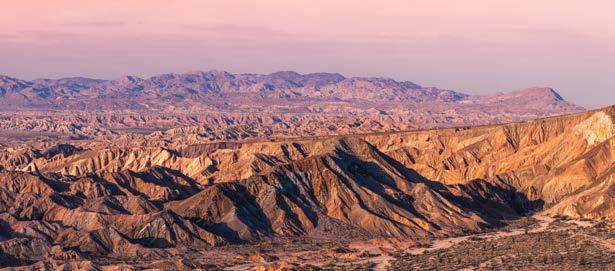
BUILDING A CLIMATE-RESILIENT CALIFORNIA STATE PARK SYSTEM 53
MITIGATING CLIMATE CHANGE
Climate-resilient parks also mitigate climate change by helping reduce or prevent the emission of greenhouse gases that are driving climate change. California aims to be carbon neutral by 2045 — meaning all carbon emissions are negated by carbon removal. The path to carbon neutrality is laid out in the California Air Resources Board’s 2022 Scoping Plan — including reducing greenhouse gas emissions by 85% by 2045, increasing solar and wind energy, and transitioning to zero-emission vehicles. Strategic land management is also key to both preventing carbon emissions and increasing carbon sequestration, which is the removal and storage of carbon from the atmosphere. These
strategies are detailed in California’s Natural and Working Land Climate Smart Strategy. Through climate-smart park operations and land stewardship, California State Parks can help California reach its climate goals.
California State Parks needs additional resources to accelerate the transition to clean energy to meet California’s 2045 goal of carbon neutrality as well as guaranteed funding and permanent staff to facilitate large-scale land management that maximizes parks’ uptake and storage of carbon.
CARBON NEUTRALITY
PARK OPERATIONS
TRANSITION TO EMISSION-FREE VEHICLES
As of April 2022, more than 25% of California State Parks’ new vehicle purchases were electric, with a goal of 50% by 2024.
MAKE FACILITIES MORE ENERGY EFFICIENT BY RELYING MORE ON SOLAR POWER AND CLEAN ENERGY SOURCES
Solar panels have been installed at parks statewide, including an 85,000-square-foot solar canopy over the Hearst Castle Visitor Center.
INSTALL CHARGING STATIONS FOR ELECTRIC VEHICLES AT ALL STATE PARKS
As of December 2022, California State Parks had installed chargers at over 20 state parks or state recreation areas.
EXAMPLES OF LAND MANAGEMENT
FORESTS
Forests cover one-third of California’s land area, and they store more carbon than any other landscape. In fact, California’s redwood forests store more carbon per acre than any other forested ecosystem on Earth.67 Therefore, restoring and preserving forests in California state parks can significantly contribute to California’s carbon neutrality goals. Forest restoration and wildfire resilience efforts help prevent large carbon emissions from severe wildfires, and healthy, productive forests also remove and sequester more carbon from the atmosphere.
SHRUBLANDS AND CHAPARRAL
Ignition prevention programs and education are important to reduce wildfire carbon emissions, and restoring high-severity burn areas can promote carbon sequestration.
DESERTS
California deserts store a significant amount of carbon68 and could become an increasingly important carbon sink as climate change worsens.69 Therefore, preserving large desert areas, e.g., acquiring land to expand Anza-Borrego Desert State Park, is a significant component of reaching carbon neutrality.
8.
54 CALIFORNIA STATE PARKS FOUNDATION
BUILDING A CLIMATE-RESILIENT CALIFORNIA STATE PARK SYSTEM — HOW DO WE GET THERE?

Since the mid-19th century, Californians have joined together to preserve the state’s stunning natural lands and protect people’s connection to nature. From environmentalists to politicians to everyday residents, Californians recognize the astounding beauty of California and the need to safeguard it for future generations. In many ways, the state park system is emblematic of the promise of California in the popular imagination and culture — a vision of sunny, sandy beaches with sparkling blue water; towering, awe-inspiring redwoods; snow-covered slopes offering superlative skiing; and wide-open chapparal landscapes. These majestic landscapes are all found in California state parks, and they are all at risk from climate change.
This report examines the key challenges and opportunities for California State Parks to expand its climate resilience work and demonstrates that the path toward a climate-resilient state park system requires a complete rethinking of what it means to be climate resilient. A multidisciplinary approach to park planning and operations is essential, and it requires guaranteed, long-term funding and a permanent team of climate adaptation experts working across relevant departments in California State Parks to build climate resilience into all aspects of the agency’s work in parks and across programs. A robust acquisition program is also critical to preserve access and create climate refuges for California’s diverse ecosystems, wildlife, and people.
Urgent action is needed to prepare and protect California state parks from the growing threat of climate change. California State Parks has already taken critical steps to achieve this aim — but more must be done. The creation of the nation’s largest and most diverse state park system required bold and audacious action, and the scale of the climate crisis demands an equally ambitious movement to build a climate-resilient state park system. We must think big and take the initiative as we reimagine the California state park system, and Californians must come together again to protect and preserve California’s beloved state parks for years to come.
55 BUILDING A CLIMATE-RESILIENT CALIFORNIA STATE PARK SYSTEM
9.
 PIGEON POINT LIGHT STATION STATE HISTORIC PARK
PIGEON POINT LIGHT STATION STATE HISTORIC PARK
NECESSARY ACTIONS AND RECOMMENDATIONS
California state parks encapsulate California’s natural beauty and extraordinary diversity — both cornerstones of the state’s history and character. Many of California’s unique landscapes and iconic species call state parks home, from the towering giant sequoia redwoods at Calaveras Big Trees State Park to the stunning western monarch butterflies at Pismo State Beach. However, state parks and the extraordinary resources they protect are increasingly threatened by climate change. Ancient forests are burning in severe wildfires, coastal parks face increasing coastal erosion and flooding caused by sea level rise, and California’s extraordinary biodiversity is under threat. The urgency of the climate crisis demands immediate and bold action to preserve California state parks for future generations, and building a climate-resilient state park system is essential.
California State Parks has proven itself as an effective and efficient steward of California’s natural resources. Despite persistent underfunding for natural resources work, California State Parks has leveraged its limited resources to increase climate resilience statewide. However, the enormity of the climate crisis demands a pace and scale of work that is not possible without adequate resources. Sustained funding and authorized staff for permanent climate resilience programs are critical for California State Parks to accelerate and expand its climate resilience work throughout the state park system.
Time is running out to prepare for and protect our state parks from the impacts of climate change, and California State Parks must accelerate and expand its climate resilience work. This massive but vital effort will require an extensive investment to counter the scale of the climate crisis, as well as a reimagining of what characterizes a climate-resilient park. Through reviewing the latest science and gathering input from stakeholders, California State Parks Foundation has developed the following long- and short-term recommendations:
57 BUILDING A CLIMATE-RESILIENT CALIFORNIA STATE PARK SYSTEM
10.

Rethink California State Parks’ representation in 30x30.
COST: Neutral
California’s 30x30 initiative aims to durably protect and conserve 30% of California’s land and coastal waters by 2030. This initiative is a critical step to preserve the state’s extraordinary biodiversity, ensure equitable access to nature, and build resilience to climate change — and California State Parks has an important role to play through both acquisition and stewardship. New parks like Dos Rios Ranch can conserve rare habitat and protect threatened species, but lands must also be properly stewarded to ensure ecosystem health in the face of growing environmental challenges. California State Parks is partnering with governmental agencies, nonprofits, and Native governments to facilitate landscape-scale conservation efforts and steward parks to be more climate resilient and support biodiversity. The agency’s work significantly contributes to the 30x30 initiative’s goals, but the important role of California State Parks is not sufficiently recognized.
Prioritizing state parks more clearly in the state’s 30x30 framework for their role in stewardship and conservation of public lands as well as providing recreational opportunities would allow the agency to tap any future investments in conservation and stewardship activities across California. For example, the Nature-Based Solutions funding package for FY 2021–24 allocated over $1 billion across numerous agencies, but state parks only received $12 million despite a staggering need. Future bond or budget investments should be more equitably distributed given California State Parks’ obligation to steward the many highly sensitive areas it manages. In addition, as the climate changes, more state park lands will become critically threatened and require a higher degree of conservation and stewardship.
58 CALIFORNIA STATE PARKS FOUNDATION
OCEANO DUNES STATE VEHICLE RECREATION AREA
Photo courtesy of California State Parks

Fund the full implementation of California State Parks’ Sea Level Rise Adaptation Strategy.
COST: $50 million in annual funding beginning FY 2025–26
Sea level rise is an existential threat that is already being felt up and down the California coast. Sea level rise is also accelerating and, at this rate, up to 75% of California’s beaches could be lost by the end of the century.7 As the manager of almost one-quarter of the California coast, California State Parks plays a key role in building a resilient coastline. The urgency of preparing California state parks for sea level rise is detailed further in Section 5.2 of this report.
California State Parks’ Sea Level Rise Adaptation Strategy lays out a cohesive approach for coastal parks to meet this threat, and it is the agency’s most advanced climate resilience plan to date. In FY 2021–22, California State Parks appropriated one-time funds of $11.5 million to implement the strategy but no authority for permanent staff positions. California State Parks has made important strides with the resources it has. However, the lack of sustained funding and permanent staff threatens the continuation and expansion of this critical work. The Sea Level Rise Adaptation Strategy describes a clear path to more resilient coastal state parks, but further support is needed to take the next step.
Funds would be used for:
n Implementing major sea level rise adaptation and resilience projects in state parks, including relocating facilities, building living shorelines, and restoring coastal ecosystems.
n Developing guidelines for coastal park management, completing vulnerability assessments and detailed adaptation plans, and developing essential tools for park managers to evaluate risk and weigh adaptation strategies.
n Hiring permanent staff to develop and implement sea level rise adaptation and resilience projects.
59 BUILDING A CLIMATE-RESILIENT CALIFORNIA STATE PARK SYSTEM
2
POINT DUME STATE BEACH
3
Authorize and fund permanent climate resilience staff across relevant California State Parks divisions (or program areas or functions) for a multidisciplinary approach to building climate resilience into all aspects of park management.
COST: $5 million+ in annual funding starting FY 2025–26

California state parks exhibit a range of adaptation needs and restoration opportunities, such as using beneficial fire to restore forest health and increase wildfire resilience, relocating facilities that are threatened by sea level rise and other climate impacts, and protecting and documenting cultural resources for future generations. This comprehensive vision of a climate-resilient state park system demands a multidisciplinary approach to park planning and operations. Climate resilience can no longer be one component of park management — what is required is a permanent team of climate adaptation experts working across relevant departments in California State Parks to build climate resilience into all aspects of the agency’s work in parks and across programs.
A multidisciplinary approach to building a climate-resilient state park system will not only help protect California state parks but will also contribute to the state’s goal of carbon neutrality by 2045. Transitioning park operations and facilities to green energy will reduce parks’ carbon footprint, and climate-smart land stewardship can reduce carbon emissions from large wildfires and increase ecosystems’ removal and storage of carbon from the atmosphere — as detailed in the Natural and Working Lands Climate Smart Strategy and emphasized in the California Air Resources Board’s 2022 Scoping Plan.
Sustained funding is essential to put this work into action, including base funding for the development of park General Plans, hiring authority for permanent staff positions, and ongoing program costs. To integrate climate resilience throughout park management, a climate resiliencefocused senior staff position should be created in each of the following California State Parks divisions:
n Natural Resources
n Cultural Resources
n Facilities and Park Maintenance
n Strategic Planning and Recreation Services
n Interpretation and Education
60 CALIFORNIA STATE PARKS FOUNDATION

Each staff person will contribute their own expertise in climate resilience to center climate adaptation in General Plans for all California state parks. This work would be conducted under the guidance of an appointed Assistant Deputy Director for Climate Resilience in Park Operations.
In addition to staff positions that enable climate adaptation to be centered in all General Plans, resources are urgently needed to streamline the long, cumbersome process of updating a General Plan (which currently can take as long as five years). If parks are to truly adapt to a rapidly changing climate, the process of planning for rapid change must be more nimble.
Expand California State Parks’ internal capacity to assess and scope adaptation projects.
COST: $10 million in annual funding beginning FY 2025–26
Due to staffing restraints, California State Parks has been forced to use external engineers and consultant firms to conduct vulnerability assessments of parks’ climate risks and propose adaptation measures to address those threats. However, as discussed in Section 5.2.2, California State Parks has a different mission than typical clients, and firms’ final recommendations require extensive modification to fit California State Parks’ needs and values. By contrast, internal engineers can conduct vulnerability assessments and propose adaptation projects that align with California State Parks’ existing requirements, ensuring that the final reports best suit California State Parks’ needs.
For California State Parks to conduct internal vulnerability assessments, the following staff positions should be created and permanently funded alongside investments for ongoing program costs:
n Structural engineers (2)
n Landscape architects (2)
n Engineering geologists (2)
n Park and recreation specialists (2)
n Environmental scientists (2)
All staff would be assigned to one of California State Parks’ two Service Centers, where multidisciplinary teams provide a wide range of support services for the ongoing management and enhancement of California state parks.
61 BUILDING A CLIMATE-RESILIENT CALIFORNIA STATE PARK SYSTEM
MALAKOFF DIGGINS STATE HISTORIC PARK
Photo courtesy of California State Parks
4

Extend funding for California State Parks’ Wildfire and Forest Resilience Program beyond its current expiration in FY 2027–28, including hiring authority for permanent staff positions.
COST: $50 million in annual funding starting FY 2028–29
Climate change has led to an unprecedented increase in the frequency, scale, and severity of wildfires in California. These fires have already had a variety of consequences for California state parks, ranging from catastrophic burns to less-severe, ecologically beneficial fires. In August 2020, the massive CZU Lightning Complex Fire burned 97% of Big Basin Redwoods State Park, the oldest state park in California. Climate projections suggest wildfires could burn 77% more acres a year by 2100,1 and the increasing size and severity of these wildfires could have devastative effects.25 Proliferating wildfires also have a major fiscal impact — recovery efforts for Big Basin Redwoods State Park are estimated to cost around $186 million.70 Increasing wildfire resilience in state parks is discussed more in Section 5.1.
California State Parks has received $160 million since 2021 for wildfire resilience work, and its Wildfire and Forest Resilience Program has taken significant strides toward increasing wildfire resilience in state parks. For example, the agency has expanded its prescribed burn program and has also managed existing wildfires to leverage their ecological benefits while keeping the burn contained. However, it will take decades to restore the historical fire regimes that are critical to wildfire resilience, and current funding expires in FY 2027–28. Sustained funding is essential to protect park resources, maintain current resilience work, and reduce future costs from repeated disaster recovery.
To achieve the necessary pace and scale of wildfire resilience work, California State Parks will require large investments to maintain and expand forest restoration and wildfire resilience efforts. A significant portion of funding would be dedicated to a large team of permanent staff, which is critical to implementing these projects at the required pace and scale.
62 CALIFORNIA STATE PARKS FOUNDATION
5
PARK STAFF INSTALL CAGES AROUND YOUNG JOSHUA TREES TO PROTECT THEM FROM PREDATION AT ARTHUR B. RIPLEY DESERT WOODLAND STATE PARK.
Establish a pilot program for California state parks as community climate resilience centers.

COST: $50 million over five years starting FY 2025–26
Californians are increasingly seeking relief from extreme heat events caused by climate change, and heat-related hospitalizations and deaths are already rising.11 In response, California developed an Extreme Heat Action Plan, which highlights community resilience centers and access to green spaces as a solution. As discussed further in Section 7, California state parks can act as climate resilience hubs to help fulfill this need. A climate resilience hub provides essential resources during extreme climate events to increase community resilience and adaptability to climate change. Parks are a natural climate refuge that can offer shade, water, shelter, and other amenities to help people escape the heat, severe storms, and other climate events. To create community-based climate resilience hubs, park facilities can be adapted or built to meet the community’s urgent needs.
To promote state parks as climate resilience hubs, a pilot program should be implemented at 10 parks that represent the diversity of state parks, including coastal, desert, forest, and chaparral landscapes, as well as various community demographics.
Funds would be used for staffing, planning, and implementation, with each park completing:
n Community outreach to learn how the park can best serve the surrounding community, address any concerns about the project, and engage community members in the decision-making process.
n An implementation plan and feasibility study for the identified projects and actions needed to meet the community’s needs.
n Project implementation to create the final resilience hub.
California State Parks can compile findings from all parks to develop a comprehensive strategy to build climate resilience hubs at parks statewide. Similar work was done by Climate Resolve, a nonprofit organization that developed a Community Resilience and Access Plan at Baldwin Hills Parklands, and its final report can be a valuable tool for California State Parks to develop an effective pilot program.
63 BUILDING A CLIMATE-RESILIENT CALIFORNIA STATE PARK SYSTEM
HENRY COWELL REDWOODS STATE PARK

Fund a robust California State Parks acquisition program.
COST: $250 million allocated from the proposed climate bond
A robust acquisition program is vital to protect California’s natural resources and help preserve the state’s extraordinary biodiversity, as highlighted in California’s 30x30 initiative, discussed further in Section 6 Acquired land can protect imperiled species, create large areas of more climate-resilient habitat, and link existing preserved areas to support regional biodiversity. Acquisitions will also become increasingly important as climate change impacts critical habitat and impedes public access to parks. For example, a strategic acquisition program that prioritizes sites for future coastal access and restoration could ensure continued access for future Californians as sea level rise increasingly alters the coastline.
Land acquisition includes both creating new parks and expanding current ones, and California State Parks has had some success in both areas. For example, the agency acquired Dos Rios Ranch Preserve in 2023 and has worked with other conservation groups to expand several parks in Southern California. However, California State Parks’ acquisition program is persistently underfunded and understaffed, which makes land transfers slow and inefficient. Dos Rios Ranch will become the first new state park in 13 years, and many nonprofits and other conservation groups are waiting to transfer land to California State Parks but are unable to do so because of the agency’s lack of capacity.
A robust acquisition program would increase California State Parks’ ability to facilitate these transfers and develop a statewide strategy for future acquisitions. A well-resourced program could also increase coordination with other mission-aligned agencies, such as the California Coastal Conservancy, Wildlife Conservation Board, and California Department of Fish and Wildlife, to enable the acquisition and preservation of larger landscapes.
In addition to providing much-needed funds to acquire high-priority properties that are already in the pipeline, work is needed to define enduring priorities for acquisition over the long term, and to govern how new acquisitions should be staffed and managed when they are added to the park system.
64 CALIFORNIA STATE PARKS FOUNDATION
7
THE RIPARIAN BRUSH RABBIT IS ENDANGERED IN CALIFORNIA.
 BURTON CREEK STATE PARK
Photo courtesy of California State Parks
BURTON CREEK STATE PARK
Photo courtesy of California State Parks
REFERENCES
1 Pierce, D., Kalansky, J., & Cayan, D. (2018). Climate, Drought, and Sea Level Rise Scenarios for the Fourth California Climate Assessment (Technical Report CNRACEC-2018-006). California Energy Commission. (Available online).
2 Collins, B. M., Miller, J. D., Knapp, E. E., & Sapsis, D. B. (2019). A quantitative comparison of forest fires in central and northern California under early (1911–1924) and contemporary (2002–2015) fire suppression. International Journal of Wildland Fire, 28(2). https://doi. org/10.1071/WF18137
3 Westerling, A. L. (2016). Increasing western US forest wildfire activity: Sensitivity to changes in the timing of spring. Philosophical Transactions of the Royal Society B: Biological Sciences, 371, 20150178. https://doi.org/10.1098/ rstb.2015.0178
4 Singleton, M. P., Thode, A. E., Sánchez Meador, A. J., & Iniguez, J. M. (2019). Increasing trends in high-severity fire in the southwestern USA from 1984 to 2015. Forest Ecology and Management, 433, 709–719. https://doi. org/10.1016/j.foreco.2018.11.039
5 Willis, J. K., Hamlington, B. D., & Fournier, S. (2023). Global Mean Sea Level, Trajectory and Extrapolation [dataset]. https://doi.org/10.5281/ zenodo.7702315
6 Beckley, B. D., Yang, X., Zelensky, N. P., Holmes, S. A., Lemoine, F. G., Ray, R. D., Mitchum, G. T., Desai, S., & Brown, S. T. (2021). Global Mean Sea Level Trend from Integrated Multi-Mission Ocean Altimeters TOPEX/Poseidon, Jason-1, OSTM/Jason-2, and Jason-3 Version 5.1. Ver. 5.1 PO.DAAC, CA, USA [dataset]. https://doi.org/10.5067/GMSLM-TJ151
7 Vitousek, S., Vos, K., Splinter, K. D., Erikson, L., & Barnard, P. L. (2023). A model integrating satellite-derived shoreline observations for predicting fine-scale shoreline response to waves and sea-level rise across large coastal regions. Journal of Geophysical Research: Earth Surface, 128, e2022JF006936. https://doi. org/10.1029/2022JF006936
8 Gutierrez, I. (2020, February 3). California’s Role Fighting the Global Biodiversity Crisis https://www.nrdc.org/ bio/irene-gutierrez/californias-rolefighting-global-biodiversity-crisis
9 California Natural Diversity Database. (2023a). State and federally listed endangered, threatened, and rare plants of California. California Department of Fish and Wildlife. (Available online).
10 California Natural Diversity Database. (2023b). State and federally listed endangered and threatened animals of California. California Department of Fish and Wildlife. (Available online).
11 Khatana, S. A. M., Werner, R. M., & Groeneveld, P. W. (2022). Association of extreme heat with all-cause mortality in the contiguous US, 2008-2017. JAMA Network Open, 5(5), e2212957. https:// jamanetwork.com/journals/ jamanetworkopen/fullarticle/2792389
12 Roos, M. (2018). Climate justice summary report (California’s Fourth Climate Change Assessment). Publication number: SUMCCCA4-2018-012. (Available online).
13 Hoffman, J. S., Shandas, V., & Pendleton, N. (2020). The effects of historical housing policies on resident exposure to intra-urban heat: A study of 108 US urban areas. Climate, 8, 12. https://doi.org/10.3390/cli8010012
14 William, D. (2015). Creating and Mapping an Urban Heat Island Index for California. CalEPA. (Available online).
15 Roos, C. I., Swetnam, T. W., Ferguson, T. J., Liebmann, M. J., Loehman, R. A., Welch, J. R., Margolis, E. Q., Guiterman, C. H., Hockaday, W. C., Aiuvalasit, M. J., Battillo, J., Farella, J., & Kiahtipes, C. A. (2021). Native American fire management at an ancient wildland—urban interface in the Southwest United States. Proceedings of the National Academy of Sciences, 118(4), e2018733118. https:// doi.org/10.1073/pnas.2018733118
16 Anderson, M. K., & Moratto, M., J. (1996). Native American Land-Use Practices and Ecological Impacts. In Sierra Nevada Ecosystem Project, Final report to Congress, Vol II, Assessments
and scientific basis for management options (pp. 187–206). Davis, University of California, Centers for Water and Wildland Resources.
17 Siirila-Woodburn, E. R., Rhoades, A. M., Hatchett, B. J., Huning, L. S., Szinai, J., Tague, C., Nico, P. S., Feldman, D. R., Jones, A. D., Collins, W. D., & Kaatz, L. (2021). A low-to-no snow future and its impacts on water resources in the western United States. Nature Reviews Earth & Environment, 2(11), 800–819. https://doi.org/10.1038/s43017-02100219-y
18 California Department of Water Resources. (n.d.). California Data Exchange Center. Snow Course Measurements for April 2023. Retrieved November 20, 2023, from https://cdec. water.ca.gov
19 Littell, J. S., Peterson, D. L., Riley, K. L., Liu, Y., & Luce, C. H. (2016). A review of the relationships between drought and forest fire in the United States. Global Change Biology, 22(7), 2353–2369.
https://doi.org/10.1111/gcb.13275
20 Desprez Loustau, M. L., Marcais, B., Nageleisen, L. M., Piou, D., & Vannini, A. (2006). Interactive effects of drought and pathogens in forest trees. Annals of Forest Science, 6(63), 597–612.
https://doi.org/10.1051/forest:2006040
21 Kolb, T. E., Fettig, C. J., Ayres, M. P., Bentz, B. J., Hicke, J. A., Mathiasen, R., Stewart, J. E., & Weed, A. S. (2016). Observed and anticipated impacts of drought on forest insects and diseases in the United States. Forest Ecology and Management, 380, 321–334. https://doi. org/10.1016/j.foreco.2016.04.051
22 Stephens, S. L., Collins, B. M., Fettig, C. J., Finney, M. A., Hoffman, C. M., Knapp, E. E., North, M. P., Safford, H., & Wayman, R. B. (2018). Drought, tree mortality, and wildfire in forests adapted to frequent fire. BioScience, 68(2), 77–88.
https://doi.org/10.1093/biosci/bix146
66 CALIFORNIA STATE PARKS FOUNDATION
23 Preisler, H. K., Grulke, N. E., Heath, Z., & Smith, S. L. (2017). Analysis and out-year forecast of beetle, borer, and drought-induced tree mortality in California. Forest Ecology and Management, 399, 166–178. https://doi. org/10.1016/j.foreco.2017.05.039
24 California Wildfire and Forest Resilience Task Force. (2022). California’s Strategic Plan for Expanding the Use of Beneficial Fire. (Available online).
25 Guiterman, C. H., Gregg, R. M., Marshall, L. A. E., Beckmann, J. J., van Mantgem, P. J., Falk, D. A., Keeley, J. E., Caprio, A. C., Coop, J. D., Fornwalt, P. J., Haffey, C., Hagmann, K. R., Jackson, S. T., Lynch, A. M., Margolis, E. Q., Marks, C., Meyer, M. D., Safford, H., Syphard, A. D., … Stevens, J. T. (2022). Vegetation type conversion in the US Southwest: Frontline observations and management responses. Fire Ecology, 18(6). https://doi. org/10.1186/s42408-022-00131-w
26 Skinner, C. N. (2005). Reintroducing Fire into the Black Mountain Research Natural Area: Effects on Hazard. In: Ritchie, M. W.; Maguire, D. A.; Youngblood, A., tech. coordinators. Proceedings of the Symposium on Ponderosa Pine: Issues, Trends, and Management, 2004 October 18-21, Klamath Falls, OR. Gen. Tech. Rep PSW-GTR-198. Albany, CA: U.S. Department of Agriculture, Forest Service, Pacific Southwest Research Station, pp. 245–257.
27 Van de Water, K. M., & Safford, H. D. (2011). A summary of fire frequency estimates for California vegetation before Euro-American settlement. Fire Ecology, 7(3), 26–58. https://doi.org/10.4996/ fireecology.0703026
28 Stephens, S. L., & Fry, D. L. (2005). Fire history in coast redwood stands in the northeastern Santa Cruz Mountains, California. Fire Ecology, 1(1), 2–19. https:// doi.org/10.4996/fireecology.0101002
29 Barro, S. C., & Conard, S. G. (1991). Fire effects on California chaparral systems: An overview. Environment International, 17(2–3), 135–149. https:// doi.org/10.1016/0160-4120(91)90096-9
30 D’Antonio, C. M., & Vitousek, P. M. (1992). Biological invasions by exotic grasses, the grass/fire cycle, and global change. Annual Review of Ecology and Systematics, 23, 63–87.
31 Harrod, R. J., Povak, N. A., & Peterson, D. W. (2007). Comparing the Effectiveness of Thinning and Prescribed Fire for Modifying Structure in Dry Coniferous Forests. In: Butler, B. W.; Cook, W., comps. The fire environment-innovations, management, and policy; conference proceedings. 26-30 March 2007; Destin, FL. Proceedings RMRS-P46CD. Fort Collins, CO: U.S. Department of Agriculture, Forest Service, Rocky Mountain Research Station. CD-ROM. pp. 329–346.
32 Boisramé, G., Thompson, S., Collins, B., & Stephens, S. (2017). Managed wildfire effects on forest resilience and water in the Sierra Nevada. Ecosystems, 20(4), 717–732. https://doi.org/10.1007/ s10021-016-0048-1
33 Radeloff, V. C., Helmers, D. P., Kramer, H. A., Mockrin, M. H., Alexandre, P. M., Bar-Massada, A., Butsic, V., Hawbaker, T. J., Martinuzzi, S., Syphard, A. D., & Stewart, S. I. (2018). Rapid growth of the US wildland-urban interface raises wildfire risk. Proceedings of the National Academy of Sciences, 115(13), 3314–3319. https://doi.org/10.1073/pnas.1718850115
34 California Wildfire and Forest Resilience Task Force. (n.d.). Beta Interagency Treatment Dashboard Retrieved November 27, 2023, from https://interagencytrackingsystem.org/
35 Hartsough, B. R., Abrams, S., Barbour, R. J., Drews, E. S., McIver, J. D., Moghaddas, J. J., Schwilk, D. W., & Stephens, S. L. (2008). The economics of alternative fuel reduction treatments in western United States dry forests: Financial and policy implications from the National Fire and Fire Surrogate Study. Forest Policy and Economics, 10(6), 344–354. https://doi.org/doi:10.1016/j. forpol.2008.02.001
36 Fox-Kemper, B., Hewitt, H. T., Xiao, C., Adalgeirsdottir, G., Drijfhout, S. S., Edwards, T. L., Golledge, N. R., Hemer, M., Kopp, R. E., Krinner, G., Mix, A., Notz, D., Nowicki, S., Nurhati, I. S., Ruiz, L., Sallee,
J.-B., Slangen, A. B. A., & Yu, Y. (2021). Ocean, Cryosphere and Sea Level Change. In V. P. Masson-Delmotte, P. Zhai, A. Pirani, S. L. Connors, C. Pean, S. Berger, N. Caud, Y. Chen, L. Goldfarb, M. I. Gomis, M. Huang, K. Leitzell, E. Lonnoy, J. B. R. Matthews, T. K. Maycock, T. Waterfield, O. Yelekci, R. Yu, & B. Zhou (Eds.), Climate Change 2021: The Physical Science Basis: Working Group Contribution to the Sixth Assessment Report of the Intergovernmental Panel on Climate Change (pp. 1211–1362). Cambridge University Press. https://doi. org/10.1017/9781009157896.011
37 Kopp, R. E., Kemp, A. C., Bittermann, K., Horton, B. P., Donnelly, J. P., Gehrels, W. R., Hay, C. C., Mitrovica, J. X., Morrow, E. D., & Rahmstorf, S. (2016). Temperature-driven global sea-level variability in the Common Era. Proceedings of the National Academy of Sciences, 113(11), E1434–E1441. https:// doi.org/10.1073/pnas.1517056113
38 Vousdoukas, M. I., Mentaschi, L., Voukouvalas, E., Verlaan, M., Jevrejeva, S., Jackson, L. P., & Feyen, L. (2018). Global probabilistic projections of extreme sea levels show intensification of coastal flood hazard. Nature Communications, 9, 2360. https://doi. org/10.1038/s41467-018-04692-w
39 Leatherman, S. P., Zhang, K., & Douglas, B. C. (2000). Sea level rise shown to drive coastal erosion. Eos, Transactions American Geophysical Union, 81(6), 55–57. https://doi. org/10.1029/00EO00034
40 Morris, J. T., Sundareshwar, P. V., Nietch, C. T., Kjerfve, B., & Cahoon, D. R. (2002). Responses of coastal wetlands to rising sea level. Ecology, 83(10), 2869–2877. https://doi.org/10.1890/00129658(2002)083[2869:ROCWTR]2.0.CO;2
41 Tebaldi, C., Strauss, B. H., & Zervas, C. E. (2012). Modelling sea level rise impacts on storm surges along US coasts. Environmental Research Letters, 7, 014032. https://doi.org/10.1088/17489326/7/1/014032
67 BUILDING A CLIMATE-RESILIENT CALIFORNIA STATE PARK SYSTEM
42 Griggs, G., & Reguero, B. G. (2021). Coastal adaptation to climate change and sea-level rise. Water, 13(16), Article 16. https://doi.org/10.3390/w13162151
43 Hoffman, R., Dailey, P., Hopsch, S., Ponte, R., Quinn, K., Hill, E. M., & Zachry, B. (2010). An estimate of increases in storm surge risk to property from sea level rise in the first half of the twentyfirst century. Weather, Climate, and Society, 2, 271–293. https://doi. org/10.1175/2010WCAS1050.1
44 California Department of Parks and Recreation, & California Coastal Conservancy. (2017). Draft Report: Sea Level Rise Assessment for Existing Facilities.
45 Griggs, G. (2005). The impacts of coastal armoring. Shore and Beach, 73(1), 13–22.
46 Griggs, G., & Patsch, K. (2019). The protection/hardening of California’s coast: Times are changing. Journal of Coastal Research, 35(5), 1051–1061. https://doi.org/10.2112/JCOASTRES-D19A-00007.1
47 Judge, J., Newkirk, S., Leo, S., Heady, W., Hayden, W., Veloz, S., Cheng, S., Battalio, B., Ursell, T., & Small, M. (2017). Case Studies of Natural Shoreline Infrastructure in Coastal California: A Component of Identification of Natural Infrastructure Options for Adapting to Sea Level Rise (California’s Fourth Climate Change Assessment). The Nature Conservancy. (Available online).
48 National Oceanic and Atmospheric Administration (NOAA). (2015). Guidance for Considering the Use of Living Shorelines. (Available online).
49 Temmerman, S., Meire, P., Bouma, T. J., Herman, P. M. J., Ysebaert, T., & De Vriend, H. J. (2013). Ecosystem-based coastal defence in the face of global change. Nature, 504, 79–83. https://doi. org/10.1038/nature12859
50 Reidmiller, D. R., Avery, C. W., Easterling, D. R., Kunkel, K. E., Lewis, K. L. M., Maycock, T. K., & Stewart, B. C. (2018). Impacts, Risks, and Adaptation in the United States: The Fourth National Climate Assessment, Volume II. U.S. Global Change Research Program. https://doi.org/10.7930/NCA4.2018
51 California Department of Parks and Recreation. (n.d.-b). State Park’s Extraordinary Biodiversity. Retrieved November 22, 2023, from https://www. parks.ca.gov/?page_id=28496
52 California Department of Parks and Recreation. (n.d.-a). Chino Hills State Park: About the Park. Retrieved November 22, 2023, from https://www. parks.ca.gov/?page_id=21973
53 Hills For Everyone. (2019). 104 Years of Wildfire History Near Chino Hills State Park. (Available online).
54 Loarie, S. R., Carter, B. E., Hayhoe, K., McMahon, S., Moe, R., Knight, C. A., & Ackerly, D. D. (2008). Climate Change and the Future of California’s Endemic Flora. PLOS ONE, 3(6), e2502. https://doi. org/10.1371/journal.pone.0002502
55 Moyle, P. B., Lusardi, R. A., Samuel, P. J., & Katz, J. V. E. (2017). State of the Salmonids: Status of California’s Emblematic Fishes (p. 579). California Trout. (Available online).
56 Dunlop, T., Glamore, W., & Felder, S. (2023). Restoring estuarine ecosystems using nature-based solutions: Towards an integrated eco-engineering design guideline. Science of The Total Environment, 873, 162362. https://doi. org/10.1016/j.scitotenv.2023.162362
57 Schuerch, M., Spencer, T., Temmerman, S., Kirwan, M. L., Wolff, C., Lincke, D., McOwen, C. J., Pickering, M. D., Reef, R., Vafeidis, A. T., Hinkel, J., Nicholls, R. J., & Brown, S. (2018). Future response of global coastal wetlands to sea-level rise. Nature, 561, 231–234. https://doi. org/10.1038/s41586-018-0476-5
58 Cooper, J. A. G., Masselink, G., Coco, G., Short, A. D., Castelle, B., Rogers, K., Anthony, E., Green, A. N., Kelley, J. T., Pilkey, O. H., & Jackson, D. W. T. (2020). Sandy beaches can survive sea-level rise. Nature Climate Change, 10, 993–995. https://doi.org/10.1038/s41558020-00934-2
59 Duda, J. J., & Bellmore, J. R. (2022). Dam Removal and River Restoration. In T. Mehner & K. Tockner (Eds.), Encyclopedia of Inland Waters (Second Edition) (Vol. 2, pp. 576–585). Elsevier. https://doi.org/10.1016/B978-0-12819166-8.00101-8
60 Switalski, T. A., & Nelson, C. R. (2011). Efficacy of road removal for restoring wildlife habitat: Black bear in the Northern Rocky Mountains, USA. Biological Conservation, 144(11), 2666–2673. https://doi.org/10.1016/j. biocon.2011.07.026
61 Robinson, C., Duinker, P. N., & Beazley, K. F. (2010). A conceptual framework for understanding, assessing, and mitigating ecological effects of forest roads. Environmental Reviews, 18, 61–86. https://doi.org/10.1139/A10-002
62 Anderson, M. G., Clark, M., Olivero, A. P., Barnett, A. R., Hall, K. R., Cornett, M. W., Ahlering, M., Schindel, M., Unnasch, B., Schloss, C., & Cameron, D. R. (2023). A resilient and connected network of sites to sustain biodiversity under a changing climate. Proceedings of the National Academy of Sciences, 120(7), e2204434119. https://doi.org/10.1073/ pnas.2204434119
63 Zellmer, A. J., & Goto, B. S. (2022). Urban wildlife corridors: Building bridges for wildlife and people. Frontiers in Sustainable Cities, 4, 954089. https://doi. org/10.3389/frsc.2022.954089
64 Ostro, B., Rauch, S., & Green, S. (2011). Quantifying the health impacts of future changes in temperature in California. Environmental Research, 111(8), 1258–1264. https://doi. org/10.1016/j.envres.2011.08.013
68 CALIFORNIA STATE PARKS FOUNDATION
65 Weir, K. (2020). Nurtured by nature. American Psychological Association, 51(3), 50.
66 Shanahan, D. F., Bush, R., Gaston, K. J., Lin, B. B., Dean, J., Barber, E., & Fuller, R. A. (2016). Health benefits from nature experiences depend on dose. Scientific Reports, 6, 28551. https://doi. org/10.1038/srep28551
67 Sillett, S. C., Van Pelt, R., Carroll, A. L., Campbell-Spickler, J., & Antoine, M. E. (2020). Aboveground biomass dynamics and growth efficiency of Sequoia sempervirens forests. Forest Ecology and Management, 458, 117740. https://doi. org/10.1016/j.foreco.2019.117740
68 Yap, T., Prabhala, A., & Anderson, I. (2023). Hidden in plain sight: California’s native habitats are valuable carbon sinks (p. 36). Center for Biological Diversity. (Available online).
69 Evans, R. D., Koyama, A., Sonderegger, D. L., Charlet, T. N., Newingham, B. A., Fenstermaker, L. F., Harlow, B., Jin, V. L., Ogle, K., Smith, S. D., & Nowak, R. S. (2014). Greater ecosystem carbon in the Mojave Desert after ten years exposure to elevated CO2 Nature Climate Change, 4(5), 394–397. https://doi.org/10.1038/nclimate2184
70 Cart, J. (2021, April 23). Battered, burned but alive: Time will heal park’s wounds, but it needs big money, too. CalMatters https://calmatters.org/ environment/2021/04/big-basin-parkheals-wildfires/
 PRAIRIE CREEK REDWOODS STATE PARK
Photo courtesy of California State Parks
PRAIRIE CREEK REDWOODS STATE PARK
Photo courtesy of California State Parks

33 New Montgomery Street, Suite 520 San Francisco, CA 94105 calparks.org
@calparks /calparks POINT DUME STATE BEACH
@calparks

 Photo courtesy of California State Parks.
Photo courtesy of California State Parks.
 LIGHTHOUSE FIELD STATE BEACH
Photo courtesy of Tim Clinton
LIGHTHOUSE FIELD STATE BEACH
Photo courtesy of Tim Clinton







 BIG BASIN REDWOODS STATE PARK
Photo courtesy of California State Parks
BIG BASIN REDWOODS STATE PARK
Photo courtesy of California State Parks












 REDWOOD NATIONAL AND STATE PARKS
Photo courtesy of California State Parks
REDWOOD NATIONAL AND STATE PARKS
Photo courtesy of California State Parks


 SONOMA COUNTY
SONOMA COUNTY





 HENRY W. COE STATE PARK AFTER THE 2020 SCU LIGHTNING COMPLEX FIRE, WHICH CLEARED THE OVERGROWN UNDERSTORY (TOP) AND LEFT A MOSAIC OF VEGETATION (BOTTOM) WITH SHORT- AND LONG-TERM ECOLOGICAL BENEFITS.
Photo courtesy of Wes Gray, California State Parks
HENRY W. COE STATE PARK AFTER THE 2020 SCU LIGHTNING COMPLEX FIRE, WHICH CLEARED THE OVERGROWN UNDERSTORY (TOP) AND LEFT A MOSAIC OF VEGETATION (BOTTOM) WITH SHORT- AND LONG-TERM ECOLOGICAL BENEFITS.
Photo courtesy of Wes Gray, California State Parks


 CRYSTAL COVE STATE PARK
CRYSTAL COVE STATE PARK




 SAN ELIJO STATE BEACH
SAN ELIJO STATE BEACH












 WORKING WITH CONSERVATION NONPROFIT CALIFORNIA TROUT, CALIFORNIA STATE PARKS WILL REMOVE RINDGE DAM IN MALIBU CREEK STATE PARK BY 2030. THIS PROJECT WILL RESTORE ACCESS TO CRITICAL HABITAT FOR ENDANGERED SOUTHERN STEELHEAD TROUT.
Photo courtesy of California Trout
WORKING WITH CONSERVATION NONPROFIT CALIFORNIA TROUT, CALIFORNIA STATE PARKS WILL REMOVE RINDGE DAM IN MALIBU CREEK STATE PARK BY 2030. THIS PROJECT WILL RESTORE ACCESS TO CRITICAL HABITAT FOR ENDANGERED SOUTHERN STEELHEAD TROUT.
Photo courtesy of California Trout








 PIGEON POINT LIGHT STATION STATE HISTORIC PARK
PIGEON POINT LIGHT STATION STATE HISTORIC PARK







 BURTON CREEK STATE PARK
Photo courtesy of California State Parks
BURTON CREEK STATE PARK
Photo courtesy of California State Parks
 PRAIRIE CREEK REDWOODS STATE PARK
Photo courtesy of California State Parks
PRAIRIE CREEK REDWOODS STATE PARK
Photo courtesy of California State Parks
